Back to Japanese Basics: The essential staples of a Japanese pantry
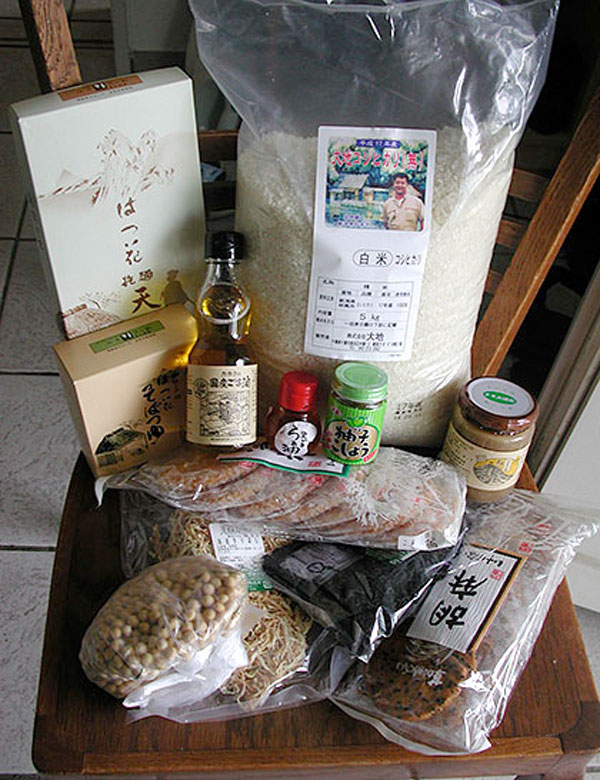
My mother, who lives in Yokohama, occasionally sends me a box of Japanese food goodies. Since she is in her own way as much of a foodie as I am, she diligently scours the land for great sources of locally produced, artisanal and/or organically produced foods. Many of these foods are known under the umbrella term sanchi chokusou(産地直送), direct from where it was produced. If you think French people are hung up on terroir, you should read some Japanese food magazine ads for sanchi chokusou products. Here's a photo of a recent box that arrived by seamail. (If you go to the flickr page, there are notes that describe what each item is.)
I'm always writing about Japanese food from the perspective of a person living outside of Japan, where it's naturally more difficult to get a hold of various ingredients. Japanese food prices outside of Japan are more often than not priced in the range of luxury gourmet items. I feel that most books written about Japanese cooking for a non-Japanese audience don't address the issue of the difficulty or expense of getting the right ingredients outside of Japan or an area with a big Japanese population. While I can rely on my mother to supplement my pantry, I've had to pare down what I do purchase and keep there while still being able to reproduce those "flavors of home".
The must-have ingredients
These are things I always have in stock. If your interest in Japanese cooking is limited, or you're on a tight budget, concentrate on this list first.
- Medium grain rice, white or brown. This is most often sold nowadays as "sushi rice". Japanese cuisine is based on rice. See this basic Japanese rice primer in the archives. See also: Looking at different types of rice.
- Japanese soy sauce. Soy sauces produced by various soy-sauce-using countries do differ. For Japanese food, use Japanese soy sauce, rather than Chinese, etc. A good, widely available and not too expensive brand is Yamasa. Kikkoman is okay, and generally not expensive since the company produces it worldwide rather than shipping it from Japan. You can spend a lot for good soy sauce, an there is a difference in flavor, but it's not totally necessary to do so for most everyday needs.
- White miso (shiromiso). There are different kinds of miso, but the white (actually a pale yellow-brown) kind is the most versatile.
- Bonito flakes (katsuo bushi). Not only is this used to make dashi stock, but it's also used as a condiment in so many foods such as tofu, blanced spinach, and so on. A purist can get a solid dried bonito and shave their own, but the pre-shaved bags are more convenient.
- Konbu seaweed. Essential for making good dashi stock, as is bonito flakes.
- Sake. In a pinch a sweet sherry can be substituted, but many Japanese foods include sake as an ingredient. You don't have to get an expensive brand - as long as it's drinkable it is fine for cooking.
- Mirin - sweet fortified liquor made from rice, used exclusively in cooking.
- Rice vinegar. Rice vinegar is mild and sweeter than white wine vinegar. You will also see something called sushi vinegar - this is just rice vinegar with added flavorings, mainly salt. Making sushi vinegar mix is so easy that I don't see a need for stocking sushi vinegar.
- Dried shiitake mushrooms. More intense in flavor than fresh, they are used a lot as a flavoring as well as an ingredient.
- Sesame seeds. These are often used toasted and ground up, or whole as a condiment.
- Dark sesame oil. This is used for flavoring many dishes, especially chuuka (Japanese Chinese-style) dishes.
- Green tea leaves. Sencha is the standard green tea (shincha is new sencha), and there is kukicha (made from the stems), genmaicha (with toasted rice), hatomugicha (with toasted barley), and so on. Matcha, or powdered green tea, is not made that much in the home (you get it at tea ceremonies, prepared by a skilled person), but it's often used nowadays for cold drinks and ice cream.
- Non-Japanese dry or bottled ingredients that are used a lot in Japanese cooking: salt, sugar, Worcestershire sauce, mayonnaise, potato starch flour or cornstarch flour, white wheat flour.
And a few essential fresh ingredients:
- Fresh ginger. Powdered ginger cannot be substituted.
- Spring onions or green onions and leeks. Leeks are used more than onions, though onions are used in a lot of Japanese Western-style dishes or yohshoku.
- White daikon radish. In Europe, mouli can be substituted. Used cooked as well as raw; in stews, soups, as garnish, etc. Grated daikon radish cuts down on the oiliness of things like tempura and grilled oily fish. In a pinch you can use red radishes instead, especially for salads, grating and so on.
Good to have ingredients
These are ingredients that are staples of a Japanese kitchen, but aren't as essential as the ones above.
- Tofu and tofu products such as aburaage (fried thin tofu), atsuage (tofu blocks that have been deep fried), kohya dofu (frozen and dried tofu, somewhat spongy), okara and yuba (very thin sheets of dried tofu). You might wonder why tofu isn't in the Essential category. While tofu is ubiquitous in Japanese cooking, you can still get Japanese flavored dishes without it.
- Wakame seaweed. This is available either preserved in salt, or dried. The dried kind is easier to handle. Used in miso soup, salads, and as sashimi garnish. See hijiki, wakame, konbu/kombu.
- Nori seaweed. The black dried sheets used to wrap sushi rolls, also used shredded as a topping and so on. It's even cooked to a paste to eat with rice.
- Seven-ingredient red pepper powder (called shichimi togarashi or sometimes nanami togarashi. Togarashi is sometimes spelled tohgarashi). This is a coarsely ground red pepper condiment that's used on udon noodles, cold tofu, and so on. It has ground up yuzu peel, sesame seeds, and other good things in it.
- Ground curry powder. Curry flavor is very popular in Japan. See curry powder formula.
- Wasabi paste or powder.
- Mustard paste or powder. This is plain mustard (equivalent to English mustard powder, e.g. Colman's), not the kind with vinegar.
- Japanese pepper (sanshou). Available usually in powdered form, though in Japan fresh sanshou is used too.
- Dried anchovies (niboshi). This is used as an alternative to, or in addition to, the classic konbu seaweed and bonito flake combination for making dashi stock in some regions.
- Ponzu. Basically a citrus juice - yuzu or sudachi plus lemon is usual. (There is also a product called Ajipon, a mixture of ponzu, soy sauce and flavorings.)
- Yuzu in various forms. Yuzu is a citrus fruit with a tangy juice and fragrant peel. You can find dried yuzu peel powder, or yuzu juice. It is possible to use lemon juice instead, though it will be different. (There are many other kinds of citrus used in Japanese cooking, such as sudachi, daidai, etc. but yuzu is the only one so far that has gaines some sort of distribution outside of Japan.)
- Various dried foods: hijiki, a dark seaweed; kanpyou, dried gourd strips often used in sushi rolls; kiriboshi daikon, dried shredded daikon radish. See hijiki, wakame, konbu/kombu.
- Various dried beans: azuki, black beans (kuromame), and white beans (ingenmame) are the most commonly used.
- Various dried noodles: soba, so-men (thin white wheat noodles), udon, etc.
- Umeboshi, or pickled plums. Nowadays touted as a macrobiotic food product, umeboshi is part of my childhood. Used in rice balls, in bento boxes, and as flavoring for various things.
- Red miso (akamiso). This is a bit stronger in taste, and usually more salty, than white miso.
- Short grain sticky (glutinous) rice (mochigome), used for some sweet and savory dishes (such as Japanese red beans and rice, or sekihan.
- Various fish-paste products such as chikuwa - used in soups and oden (a sort of stew).
- Shiso leaves. Shiso (perilla) is the most common herb used in Japanese cooking, about as useful as fresh basil is in Italian cooking. The green kind is used fresh, and the red kind is used for pickling.
- Sesame chili oil (ra-yu). Dark toasted sesame oil infused with red chili. This can turn rancid fast so store after opening in the refrigerator.
- Rice bran for pickling (nuka). People of an older generation in Japan pine for the flavor of nuka zuke - vegetables pickled in wet fermented rice bran. I seem to have been born younger than the nuka zuke cutoff point or something, since I don't really miss this type of pickles, though I have thought about making my own nuka doko (rice-bran pickling bed). It's sort of like minding a sourdough base.
- Instant dashi stock granules, as backup.
Not essential at all
There are lots of these of course, but here are a few that are often mentioned as 'essential' Japanese ingredients, but I have little use for.
- Tamari soy sauce. This is a pet peeve of mine, but I find it rather annoying when tamari is touted as a more 'real' soy sauce than regular soy sauce in some circles. Tamari literally means the dregs; it's the dark, somewhat viscous soy sauce at the bottom of the barrell. Tamari is traditionally only used as a dipping sauce.(Conversely, in Kyoto, which has arguably the most refined cuisine in all of Japan, they regard the regular dark soy sauce that is used in the rest of the country as an inferior product that contaminates the color and flavor of foods too much, and prefer a light colored soy sauce.)
- Furikake. I will write about furikake in depth soon, but in a nutshell it's a dried, flaked topping for rice (if you remember that Japanese food mostly centers around plain, white rice, a lot of things make sense) and comes in various flavors. A certain "gourmet" newsletter lists it as some kind of wonder food, which is sort of funny since I always grew up with the notion that furikake was sort of low-class. My maternal grandfather, a rather strict gentleman, didn't allow it on his table. But I do love it. Keep in mind that most commercial furikake is loaded with MSG. I like to make my own as time allows - see furikake recipes on Just Bento.
- Ajinomoto, aka MSG. A lot of Japanese households still have a bottle of this, but I find the flavor a bit too harsh.
For more about Japanese flavors, see the SaShiSuSeSo article from the archives. And if you are serious about Japanese cooking, don't miss the Japanese essence in a bottle.
See also
- About Japanese ingredients and substitutions
- Essential Japanese cooking equipment
- A dozen Japanese herbs and vegetables to grow
- Looking at rice
- Japanese miso primer
Japanese basics: Essential Japanese cooking equipment
Since I posted my article about essential and not-so essential Japanese ingredients, a number of people have asked about the equipment I use for preparing Japanese food. It's taken me a while to get to it, but here it is finally. (You can consider this as a kind of gift guide for anyone who's into Japanese cooking too..'tis the season and all that after all!)
The list of special equipment that I do have besides the things you might find in any European-style or American-style kitchen is not that long, but there are some items that I find are well worth having. Keep in mind that, as usual, I'm speaking from the perspective of someone who doesn't live in Japan. If I lived in Japan chances are I'd have a lot more Japanese cooking-only items, such as a square pan for making atsuyaki tamago (the thick, square slightly sweet omelette often served in sushi restaurants). I also use some substitutes for things that I can use for Japanese cooking methods as well as other cuisines, as you'll see.
My must-have items
 A good rice cooker. If you make rice, any kind of rice, more than once a week, you will never regret getting a rice cooker. [Update: a detailed look at rice cookers.
A good rice cooker. If you make rice, any kind of rice, more than once a week, you will never regret getting a rice cooker. [Update: a detailed look at rice cookers. A wooden rice container, or hangiri. It's tempting to use the "keep warm" feature of your rice cooker, but if you want the best tasting rice don't! Once rice is cooked, you need to fluff it up with a rice paddle, then ideally transfer it to a container that breathes - like a wooden hangiri or ohitsu. Mine is narrower and taller than the one pictured, which is meant for sushi rice, but it serves the same purpose. (Also I haven't been able to find an online source for the tall narrow kind of ohitsu so far...if you know of one please let me know.) If you are making sushi rice you must take the rice out and put it in a hangiri (see my Japanese rice primer).
A wooden rice container, or hangiri. It's tempting to use the "keep warm" feature of your rice cooker, but if you want the best tasting rice don't! Once rice is cooked, you need to fluff it up with a rice paddle, then ideally transfer it to a container that breathes - like a wooden hangiri or ohitsu. Mine is narrower and taller than the one pictured, which is meant for sushi rice, but it serves the same purpose. (Also I haven't been able to find an online source for the tall narrow kind of ohitsu so far...if you know of one please let me know.) If you are making sushi rice you must take the rice out and put it in a hangiri (see my Japanese rice primer). - For mixing and scooping rice, you'll need a good rice paddle. Chances are you will get a free one with your rice cooker, otherwise a slightly curved one is handy. (The curved one is really handy for scooping up non-sticky grains, such as basmati rice).
 A carbon-steel wok. I know that a wok is Chinese in origin, but every Japanese household uses a wok extensively - for stir-frying tasks and for deep-frying too. There are oil-draining racks designed to fit around the perimeter of a wok. If you have an electric or induction range like I do, you must get a wok with a heavy, flat bottom - that stays flat.
A carbon-steel wok. I know that a wok is Chinese in origin, but every Japanese household uses a wok extensively - for stir-frying tasks and for deep-frying too. There are oil-draining racks designed to fit around the perimeter of a wok. If you have an electric or induction range like I do, you must get a wok with a heavy, flat bottom - that stays flat. - Several flat bamboo or water-resistant wicker baskets/sieves, or zaru. I haven't seen these offered online (so far) but you can often find them at Asian gift and food stores, and even in some department stores. Woven bamboo ones are the best since they are water-resistant and clean easily. These are used for serving things like cold noodles (soba, or buckwheat, cold udon, thin so-men, and so on). I also have some small ones which I use sometimes to make round-shaped tofu. There is a big difference between serving noodles in a plain old colander vs. on a nice bamboo zaru.
- A bamboo sushi rolling mat. If you make sushi rolls this is an essential tool. You can also use it for making other rolls (like flavored spinach wrapped in nori).
- Saibashi - long, uncoated wooden chopsticks, connected together with a piece of string. I have several pairs of these which I find essential for picking things up and turning them, stirring things around, and so on, If you're not used to handling chopsticks you may find a pair of tongs to be easier to manipulate.
Great substitutes
The following items are ones that are not Japanese, and which might not be used much in Japan, but I've found to be very good for Japanese cooking.
 A cast-iron stovetop grill pan. In Japan I might use an yakiami for grilling fish and shiitake mushrooms, but here I find a cast iron grill pan to do the job just as well. It also works great on an electric range (for an yakiami you need a gas flame).
A cast-iron stovetop grill pan. In Japan I might use an yakiami for grilling fish and shiitake mushrooms, but here I find a cast iron grill pan to do the job just as well. It also works great on an electric range (for an yakiami you need a gas flame).
 Enamelled cast-iron pans. There are a lot of Japanese dishes that involve gentle stewing, such as nikujaga (stewed meat and potatoes). There are also nabemono which are big pots of meat or fish and vegetables all cooked together. For these kinds of dishes, in Japan I might use an earthenware pot called a donabe, but here I find the heavy, enamelled cast-iron pots made by Le Creuset to be very useful, since they cook things very evenly. Since they are so pretty to look at I can use them for serving in-pot too. Finally, if you don't want to invest in a rice cooker, a cast-iron pot is the ideal container for cooking rice on the stove top.
Enamelled cast-iron pans. There are a lot of Japanese dishes that involve gentle stewing, such as nikujaga (stewed meat and potatoes). There are also nabemono which are big pots of meat or fish and vegetables all cooked together. For these kinds of dishes, in Japan I might use an earthenware pot called a donabe, but here I find the heavy, enamelled cast-iron pots made by Le Creuset to be very useful, since they cook things very evenly. Since they are so pretty to look at I can use them for serving in-pot too. Finally, if you don't want to invest in a rice cooker, a cast-iron pot is the ideal container for cooking rice on the stove top. - A sturdy metal strainer is useful for straining the bonito flakes out of your dashi stock and other tasks (the Japanese housewife might do this by adeptly picking it out with her saibashi, see above).
- A good, heavy frying pan or two. I use three frying pans: a stainless steel one and two non-stick ones.
As you can see the list is not that long. The only other things you need are a couple of good knives. Knives are a whole topic unto themselves, so I'll leave that for another day.
Serving Japanese food
Besides the cooking equipment I have a variety of Japanese bowls and serving dishes I've accumulated over the years. If you're starting out on this road you can get a lot of very nice things from eBay these days. Jlist also carries many traditional and fun authentically-Japanese serving items. If you want to present a minimalist kind of plating though, just serve your Japanese food on plain white plates, and use plain white bowls for rice and soup. Don't forget to use chopsticks though!
Filed under: basics equipment japanese100 Japanese foods to try
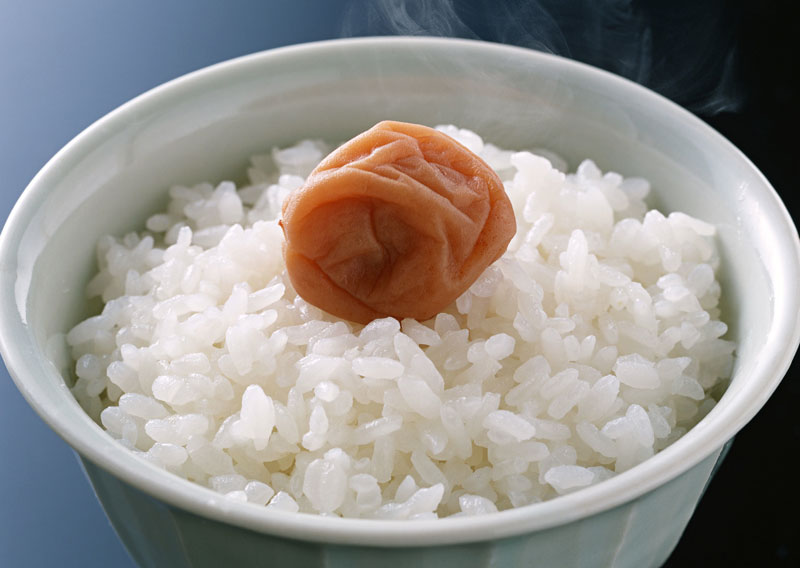
This is a list I originally created in 2006. I haven't really revisited it since then, but I have cleaned up some unnecessary cruft (i.e., you no longer have to click on something to see the descriptions). I may come up with another list sometime....
What 100 Japanese foods would I recommend people try at least once?
I tried to keep away from foods that are only available in certain regions, or even certain restaurants or homes (e.g. my aunt's homemade udon) and stuck to foods that are widely available in Japan. I've also tried to include foods from all categories and all price ranges, from wildly expensive matsutake mushrooms to cheap and sometimes not so good for you snacks. I also did not limit the list to 'genuine Japanese' foods (純和風), but include Western-style yohshoku dishes and a sprinkling of chuuka (imported Chinese) foods that are so ingrained in Japanese food culture that most people barely think of them as Chinese any more. And of course, I have eaten all of the foods listed at least once - in most cases many, many times. I like them all!
The list is not numbered in order of preference. It's just how I happened to list them.
What, no sushi?!
Nigiri-zushi and the most common types of sushi are not on the list, because I am assuming that if you are reading this, you've already had sushi. (Though... are you sure you've had great sushi at a top notch sushi-ya? See Judging a good sushi restaurant.)
A List of 100 Japanese Foods To Try At Least Once
- Properly washed and cooked, top quality new harvest white rice (shinmai 新米) I cannot emphasize enough the importance of rice in Japanese cuisine. The ultimate rice for most Japanese people comes from famed rice growing areas such as Niigata prefecture or Akita prefecture; famous varieties include _koshihikari_ and _sasanishiki_. And the best tasting rice is held to be new harvest rice or _shinmai_ 新米. The older rice gets, the less desirable it is. This differs from some other rice cultures where aged rice (e.g. basmati rice) is held in high regard. See also How to cook Japanese rice.
- Freshly made tofu, as hiyayakko or yudofu Tofu used to be sold by mobile street vendors, who would go around neighborhoods in the evening (just before dinnertime) tooting a loud horn. Housewives would rush to the vendor cart, bowls in hand, to buy fresh tofu. Nowadays mobile _tofu-ya_ have virtually disappeared in Japan, but small independent tofu stores do still exist. Most people just buy tofu from a supermarket or _combini_ though. See how to make your own tofu; how to make hiyayakko and agedashi dofu (another great way to enjoy tofu). Yudofu (湯豆腐)is a piping hot version of hiyayakko.
- Properly made misoshiru and osumashi Misoshiru 味噌汁 is miso soup, an osumashi おすまし is clear soup, both fundamental parts of a traditional Japanese meal. Some people have a bowl of miso soup or clear soup at every meal. The difference between a miso soup made with proper dashi stock and good miso and an ersatz 'instant' one is like night and day. See Miso and miso soup basics and A week of miso soup.
- Properly made homemade nukazuke Nukazuke 糠漬け are vegetables pickled in a fermente rice-bran (nuka 糠)bed or nukadoko (糠床). The vegetables are only left in the pickling bed for a few days. The care and feeding of a good nukadoko is a complex, much discussed matter, similar to the cult surrounding sourdough. The housewife or restaurant that has a top notch nukadoko is much respected. Unfortunately, nuka pickling at home seems to be a slowing dying art.
- Very fresh sanma (saury), sizzling hot from the grill, eaten with a drizzle of soy sauce and a mound of grated daikon radish Simply grilled fresh fish is a keystone of Japanese meals. Smaller fish such as sanma or the higher-class aji (horse mackerel) are grilled whole with their skins on, heads intact and innards left in, including sperm sacs or eggs. All parts of the fish are considered edible, and the innards are considered to be delicacies. Blue/oily fish or hikarimono (ひかりもの) are at their best in the colder months when they have more fat. Sanma used to be considered to be poor peoples' food since it was so cheap.
- Homemade umeboshi Umeboshi (梅干し)- salted, dried then pickled ume (梅), a fruit that is a relative of the plum and the apricot. Very salty-sour, and acquired taste. Used in small quantities, it's a great flavor enhancer and appetite stimulant. Homemade is usually the best, and despite the effort it requires a lot of people still make their own umeboshi every year (including my mother). An acquired taste. See New rice and pickled plum and Oba-chan's pickled plums.
- Freshly made, piping hot crispy tempura. I prefer vegetable tempura like shiso leaves, eggplant and sweet potato. Tempura 天ぷら is considered to be a quintessential Japanese foo these days, but it's actually an early imported food, introduced by Portuguese and/or Spanish missionaries in the 16th century. (See Wikipedia.) Good tempura must have crispy, light-as-air, greaseless batter coating. The usual dipping sauce is a mixture of dashi stock, soy sauce and grated daikon radish called tentsuyu (天つゆ), not, as you might think from the way tempura-like fried foods are served in pan-Asian restaurants, sweet and sour sauce! (yeah yeah, I still haven't posted a tempura recipe here! Someday I'll fix that...)
- A whole grilled wild Japanese matsutake Matsutake (松茸)is a very fragrant, highly saught after, and __expensive as all heck__ mushroom. In Japan it grows near matsu (松)trees, which are supposed to greatly enhance their aroma. Matsutake are as highly regarded in Japan as truffles are in Europe. Japanese matsutake prices can reach four figures (in U.S. dollars) per kilo; imported matsutake are held in much lower regard, and are often sprinkled with 'matsutake essence' while cooking. The best way to eat a matsutake is to simply grill it over a hot charcoal fire, and sprinkle with a tiny amount of soy sauce and so on.
- Freshly made sobagaki with sobayu Soba (蕎麦)or buckwheat is best known in the noodle format. But the best way to enjoy soba in my opinion is as sobagaki (そばがき), a chewy-soft dumpling of sorts made out of fresh buckwheat flour, boiled in water. The cooking water is called sobayu (そば湯)and is sipped along with the sobagaki. This is a warm dish by the way.
- Mentaiko from Fukuoka, or tarako Mentaiko (明太子)and tarako (たらこ)are both marinated/salted pollack roe, even though the name tarako means "child of cod". Mentaiko is a spicy version, which originated in Korea and crossed the sea to the southern island of Kyuushuu. Fukuoka, the largest city in Kyuushuu, is famous for its mentaiko. Both tarako and mentaiko can be eaten as-is with plain rice, or used as a paste or sauce - see tarako and ponzu pasta. Tarako is often used griled until firm as an onigiri filling. (Mentaiko onigiri is not that common, probably because it's pretty expensive!) Tarako or mentaiko mixed with a bit of butter and spread on hot toast is delicous. An acquired taste.
- Onigiri with the three classic fillings: umeboshi, okaka, shiozake Okaka (おかか)is bonito flakes mixed with soy sauce; shiozake (塩鮭)is salted salmon. See Onigiri FAQ.
- Assorted fresh-as-possible sashimi Sure sushi is great, but the ultimate indulgence at a sushi-ya for me is a selection of fresh sashimi; it's beautiful to behold and a treat for the tastebuds. Be adventurous and try everything form raw (live) shellfish to raw squid to slices cut from a still live fish! (This is called ikezukuri (活け造り or 生け作り)Yes I know, it's cruel, but it's very Japanese.)
- Saba oshizushi 鯖押し寿司 is sushi you won't often encounter in sushi restaurants, though some Japanese restaurants do have it on their menus. It is a speciality of Okayama prefecture, but is popular all over Japan. Very fresh mackerel or saba (鯖)is fileted, salted and marinated, then pressed firmly onto a block of sushi rice; the whole is then left to rest for a few more hours. It's a style of sushi that is much older than the nigiri-zushi you are probably familiar with.
- Mugicha 麦茶. See Mugicha article.
- Kakifurai 牡蠣フライ - breaded and deep fried whole oysters, a yohshoku dish. You may not think this is that Japanese...but that crispy, slightly bitter, creamy-seafoo flavor, eaten with Bulldog sauce, is very Japanese to me, an is something I really miss! (Oysters in Switzerland are Way Way Too Expensive.)
- Morinaga High-Chew candy, grape flavor I know I'm biased, but I think Japanese confectionery companies make the best tasting candies. I didn't say chocolates or candy bars - I mean candies, or sweeties if you are of British inclination. Morinaga's High Chew line of soft chewable candies are among the best and most popular, and of these the grape flavor is my
- Karasumi
からすみ is salted and dried mullet roe. It has a very dense, sticky yet waxy texture (sort of like a salty-fishy an not sweet fudge), and is very salty. It's one of the 3 great delicacies, or chinmi (珍味)of Japan; the others are salted sea urchin (shiuni) and sea cucumber innards (konowata), both of which are sort of stomach-turning for me, but karasumi is an oddly addictive substance. You traditionally eat tiny slices of it to accompany your sake. Very much and acquire taste.- A pot of oden, preferably with homemade components especially ganmodoki, boiled eggs and daikon radish
おでん - see oden article and recipe.- Ika no shiokara
いかの塩辛 is cuttlefish squid that is salted and fermented in its own innards. It has a slimy sort of texture, and a very intense sea-flavor. Great on hot rice. An acquired taste. Easily obtainable in jars at larger Japanese grocery stores; if you can get very fresh squid with the innards you can make your own at home. This recipe on Chowhound should work well, but use a non-reactive, glass or ceramic container; this is powerful stuff that will at the very least stain and odorize a plastic container forever, and may even eat through thin plastic (I've had this happen...)- Calpis
カルピス is a sweet fermented milk beverage. It's most commmonly sold as a concentrate, which is mixed with cold water or plain at a 1:5 or so ratio. It's also used straight as a syrup over shaved ice (kakigouri かき氷), and as a mixer in some cocktails. Because of its fermented flavor, cloying mouthfeel and (for English speakers) rather unfortunate name which sounds like 'cow piss', it hasn't seen a whole lot of success in the West, though as "Calpico" in already diluted or soda form it is sold in some parts of Asia. An acquired taste. Japanese people love fermented-milk flavor (see Yakult below). (Switzerland also sells a fermented-milk beverage called Rivella, which tastes a bit like Calpis/Calpico soda.)- Ankou nabe
あんこう鍋 - monkfish hotpot or stew. Tabletop cooking is very popular in Japan. A small portable gas burner is placed in the middle of the dining table, a variety of cut up vegetables and some kind of protein are made ready, and they're cooked in a pot (in which they are called nabemono 鍋物 or simply nabe 鍋)of simmering water/broth, on a grill or shallow pan. Everyone at table picks out the pieces they want. Ankou is monkfish, a rather slippery, chewy fish with tons of flavor; together with lots of vegetables it makes a delicious nabe on cold winter days.- Unadon
うな丼 is unagidonburi (うなぎどんぶり)shortened; it's eel filets with a sweet-salty sauce on a bed of rice. A very rich, high calorie dish that's popular in the summer months, since all those calories in eel are supposed to keep your strength up!- Komochi kombu or kazunoko
Kazunoko (数の子) is brined herring roe, and komochikonbu (子持ち昆布)is the same herring roe pressed onto konbu seaweed. Both have a distinctive crunchy texture and the salty flavor of the sea. An acquired taste.- Yamakake, grated yamaimo with maguro (red tuna) cubes (or just tororo with a raw egg)
Japanese people love food with a slippery, slimy texture, and the slimiest of them all is grated yamaimo (山芋) or nagaimo (長芋), a type of yam. This is called tororo (とろろ, not totoro!). My form of tororo is when it's combined with cubes of fresh tuna, which is called yamakake (山かけ), but the ultimate slimy experience is tsukimi tororo (月見とろろ), a bowl of grated yamaimo with a raw egg which is supposed to look like a full moon.- Properly made gyokuro shincha
玉露の新茶、new-crop Gyokuro green tea. How to brew a perfect cup of green tea.- Milky Candy
ミルキーキャンディー is a classic candy, with a character called Peko-chan who has graced the packaging since 1950. It is made by Fujiya (不二家). It tastes like condensed milk in candy form, and is another example of how Japanese people like that sweet, rather curdled milk taste.- Wanko soba
ワンコ蕎麦 or わんこそば. I'm breaking my 'no regional food' rule a bit, though you can get wanko soba outside of the region where it's a speciality (the Iwate prefecture in the north). Wanko soba is served in small bowls filled with a very strong tsuyu or soba sauce (cold) with various condiments (see Cold soba with dipping sauce). The customer holds the bowl out, into which the servers throw in a few strands of soba noodles. The customer slurps these up rapidly, and more strands are thrown in. This is repeated until the eater is full. An average male eater can consume about 60 servings. It's a gimmick, and encourages rapid eating. Wanko soba eating contests are the precursor of extreme eating competitions which are so popular in Japan.- Omuraisu with demi-glace sauce
オムライス is another example of yohshoku. The best place to have an omuraisu is at a small restaurant that specializes in yohshoku and makes their own demi-glace sauce. Failing that, a quick homemade version with ketchup is almost as nice. It's a big with kids in Japan.- Handmade katayaki senbei
煎餅 - せんべい - means rice cracker, but the little snack-sized rice crackers that are now as common as potato chips around the world are at the bottom of the rice cracker quality scale. At the top are hand-crafted 堅焼き煎餅 (katayaki senbei); round rice crackers the size of your palm or bigger, made of pounded rice that is formed by hand, dried under the sun, and toasted over a charcoal fire until the rice patty pops and forms crunchy air pockets. It is then painted with dark soy sauce. The sweet version is then sprinkled with big grains of salt caled ざらめ (zarame).- Yohkan (yokan) from Toraya
羊羹 - ようかん - is a dense, fudge like cake of sweet azuki beans; sometimes it contains chestnuts or other ingredients. To be eaten in slowly, in tiny mouthfuls, with green tea. The best yohkan is widely held to be from the old wagashi maker Toraya (とらや); a gift in a Toraya bag has much cachet throughout Japan.- Ishi yakiimo
石焼き芋 (いしやきいも) are sweet potatoes cooked in hot stones, available from street vendors; a fixture on cool fall evenings. See Hoku-hoku is fall.- Natto
納豆(なっとう)- fermented, sticky/slimy soy beans. The quintessential 'eww' Japanese food item. Definitely an acquired taste. See Natto article and The Great Natto Diet Rush.- Fresh seaweed sunomono (can also have some tako in it)
酢の物(すのもの)- a salad of sorts, usually with seaweed and/or seafood, with a slightly sweet, oil-less vinegar dressing. Very low in calories and very refreshing. The best is made with fresh seaweed, tasting of the sea; some chunks of fresh tako (タコ) or octopus are a nice addition. See wakame no sunomono recipe using dried wakame seaweed, which is all we can get here in landlocked Switzerland...(cries)- Ikura or sujiko
Sujiko - すじこ is salmon eggs still encased in the egg sac, while ikura - いくら is the eggs removed from the sac membrane. Both are cured in salt or soy sauce and eaten raw. The best way to enjoy either is to just mound it on top of a bowl of rice, perhaps with a little grated fresh wasabi. A speciality of Hokkaido.- Tonkatsu
トンカツ or 豚カツ is a breaded and deep-fried pork cutlet, a typical yohshoku dish. See Tonkatsu recipe.- Goma dofu
胡麻豆腐 is an example of shoujin ryouri (精進料理), the refined vegan cuisine developed by Zen Buddist monks. See goma dofu recipe.- Chawan mushi or tamago dofu - the same dish either piping hot or ice cold
Chawanmushi - 茶碗蒸し is the hot version of tamago dofu - 卵豆腐; both are delicate, smooth, savory egg custards. See Tamago dofu recipe.- Freshly made mochi, with kinako and sugar, grated daikon and soy sauce or natto
Mochi - 餅 or pounded sweet rice, is available in many forms. As a symbol of bounty a tier of two or three rounds of mochi are placed in front of the Shinto altar in the home for the New Year (called kagami mochi). The best mochi is freshly pounded, eaten with brown sugar and kinako (toasted soy bean powder), or with grated daikon radish and soy sauce, or even with natto and green onions. That's the way they were served at my grandparents' house when I was very little.- Gindara no kasuzuke
銀ダラの粕漬け is gindara, or silver cod, marinated in sakekasu (酒粕), sake lees mixed with other ingredients such as salt or soy sauce, mirin, and so on. The fish is marinated for a day or more, then grilled. The sweet-salty taste of the marinade permeates the firm fish and the result is heavenly.- Hoshigaki
干し柿 are dried persimmons (kaki). Bitter persimmons (渋柿 shibugaki) are hung outside to dry slowly; the bitter liquid drips out as the fruit dries, leaving a densely sweet delicacy. The bitter liquid is saved and used to lacquer wooden bowls and boxes.- Inarizushi
Sushi rice stuffed into fried bean curd (油揚げ aburaage) pockets. Typically a homemade sushi, rather than one served in a sushi restaurant. See Inarizushi recipe.- Chikuzen-ni
筑前煮 ちくぜんに is a homely dish in which cut up chicken, lotus root, carrots, taro root, burdock root, shiitake mushrooms etc. are stewed together in a dashi broth. It is made in large quantities for the New Year's period, when it's heated up daily and eaten during the holidays (giving the cook of the household a break from daily cooking). It can be eaten at any time of the year though, especially the cold months. Filling and healthy!- Surume
するめ is salted and dried squid' it's chewy, rather like squid jerky. It is usually eaten shredded into fine strips; you can get it like that, or the whole squid (better quality surume is usually sold whole, to be grilled briefly at home). A standard snack to accompany sake (おつまみ otsumami - see Yakitori below). My stepfather loves freshly grilled surume with a little mayonnaise and chili pepper (ichimi or nanami tougarashi).- Yakinasu with grated gingerfav44
焼き茄子 やきなす - grilled eggplant, with しょうが shouga (ginger) and a bit of soy sauce, is a summertime The slim eggplants are grilled whole, without any oil, until they soften and the skin bursts; the charred skin is then peeled off, leaving the flower bract. The peeled eggplant is eaten ice cold.- Tamago kake gohan
卵かけご飯 たまごかけごはん is just hot, freshly cooked white rice with a raw egg plus a little soy sauce. To make this, mound a rice bowl with rice, and make a hole in the middle. Drop in a fresh egg an add soy sauce; mix. A breakfast- Kabuki-age
歌舞伎揚げ is a round, deep fried rice cracker that has a distinctive crackly surface. It originated as a snack served at 歌舞伎 かぶき kabuki theaters, allegedly. Nowdays it's a cheap and rather fattening snack.- Nikujaga
肉じゃが - Japanese meat and potatoes, quintessential お袋の味 おふくろのあじ ofukukuronoaji ("mother's cooking"). See my mom's nikujaga recipe.- Spinach gomaae
ほうれん草のごま和え ほうれんそうのごまあえ hourennsou no gommae - more "mother's cooking". Spinach, and other dark green leafy vegetables are always served cooked in traditional Japanese cuisine, usually quickly blanched as a side dish. Besides sesame dressing, a simple お浸し おひたし ohitashi (dashi stock and/or bonito flakes and soy sauce sauce) is also very popular. See how to blanch spinach, and gomaae and ohitashi recipes.- Fuki no tou
ふきのとう - butterburr shoots, blanched and de-bittered and cooked in a typically Japanese sweet-salty sauce. Since butterburr shoots are only available in the spring, this is a very seasonal dish. Other highly treasured spring vegetables include わらび warabi - bracken fern (shoots), よもぎ yomogi - a type of chrysanthemum, and 筍 たけのこ takenoko - bamboo shoots.- Okonomiyaki
お好み焼き おこのみやき - popular street food, originating in Osaka but now popular all throughout Japan and beyond! Often erroneously called Japanese pizza, I think it's more aptly described as a savory pancake. See Osaka style okonomiyaki recipe.- Yakitori
焼き鳥 やきとり - skewered and grilled chicken bits. Very popular street food and 酒の肴 さけのさかな sake no sakana - drinking snack. (Competition between Japanese 居酒屋 いざかや izakaya - traditional pubs for the quality of their sake no sakana (also called おつまみ otsumami) is fierce, just like tapas in Spain.)- Ohagi
お萩 おはぎ - a traditional sweet, eaten in the fall. Very similar to ぼた餅 botamochi. See Ohagi/botamochi recipe.- Japanese style curry, with rakkyo and fukujinzuke as condiments
カレーライス kareh raisu is different from other curries! See recipe and a bit of the history of 'curry rice' in Japan.- Kenchinjiru
けんちん汁 けんちんじる is a clear yet hearty vegetable soup. It is one of the most famous 精進料理 しょうじんりょうり shoujinryouri (a refined vegan cuisine developed by Zen Buddhist monks in the Kansai region) dishes. A variation of kenchinjiru with bits of pork in it is called 豚汁 とんじる tonjiru.- Yakult
ヤクルト is a sweet, slightly fruity, fermented probiotic milk drink that is supposed to be good for your digestive system. It's sold all around the world now, with plenty of imitators. Included here because it is really very post-war-Japanese. Also see Kalpis above (which doesn't make probiotic claims, but has a similar taste).- Kakipea
A snack made up of spicy little rice crackers called 柿の種 かきのたね kaki no tane (literally: persimmon seeds) and roasted peanuts. See needlessly long and obsessive article.- Takoyaki
たこ焼き たこやき - another popular street snack that originated in Osaka. Puffy creamy doughy balls with a piece of octopus inside, served with a sauce. Best eaten piping hot. Frozen takoyaki are a pale, sad approximation of freshly made takoyaki. See takoyaki recipe (the video referenced is no longer available, but you can still follow the instructions I hope!)- Sakura mochi
桜餅 さくらもち is a traditional sweet that is eaten in spring, to coincide with the cherry blossom season. Sticky rice that is half-beaten and dyed a pale pink is wrapped around 餡 あん an - sweet azuki bean paste. The whole thing is then wrapped with a preserved cherry tree leaf, which is slightly sour-salty.- Buta no kakuni
豚の角煮 ぶたのかくに - braised pork belly. Similar to a Okinawan dish called ラフテー - rafuteh. Japanese people eat a lot more pork than beef (other red meats are not eaten much). The butcher in my grandparents' town in Saitama prefecture (right next door to Tokyo) didn't even carry beef until the 1980s. See Buta no kakuni recipe.- Daigaku imo
大学芋 だいがくいも literally means "university potato", probably because this hearty sweet snack is sold at the big university festivals that are held in the fall. Sweet potato chunks are deep fried then dipped in sugar syrup, which forms a hard, caramel-flavored coating, then sprinkled with sesame seeds.- Kappa Ebisen
かっぱえびせん is a puffy, crunchy shrimp flavored snack, manufactured by Calbee. Yes, Japanese cuisine purists will turn their noses up at this selection no doubt! But I love Kappa Ebisen, it's very Japanese, and it's here. It actually has ground up shrimp in it, so the maker claims that it's a good source of calcium!How Kappa Ebisen is made (Flash page in Japanese).- Tori no tsukune
鶏のつくね とりのつくね - soft stewed chicken dumplings. Another example of 'mother's cooking'. Fish tsukune (mainly made of oily fish like herring or mackerel) are also popular. Chicken tsukune recipe.- Hakusaizuke
白菜漬け はくさいづけ is salt pickled nappa or Chinese cabbage, a pickle for the cold winter months. (This is turned into kimchi in Korea.)- Hayashi raisu
ハヤシライス is Japanese beef stew. See recipe and main article.- Goya champuruu
ゴーヤチャンプルー is perhaps the best known dish of Okinawan cuisine. Its main feature is the use of bitter gourd, which is stir-fried with pork, egg and tofu to make a hearty dish. It's supposed to give you lots of energy yet cool your body at the same time, making it perfect for the tropical climate of Okinawa.- Dorayaki
どら焼き どらやき is another traditional Japanese sweet (wagashi). Sweet azuki bean paste is sandwiched between two small pancakes.- Ochazuke
お茶漬け おちゃづけ is rice with various salty/savory toppings, over which hot green tea is poured. It's often served as the last course in a formal Japanese meal, and it's also a popular midnight snack. See main ochazuke article.- Sakuma Drops
佐久間ドロップ or サクマドロップ are fruit flavored hard candies manufactured by Sakuma Seika. (Seika means 'confectioner'; there are actually two companies called Sakuma Seika, both manufacturing hard candies, run by rival members of the same family!) The candies are coated with powdered sugar, which prevents them from sticking together, and come in a reclosable can. This candy bridges the gap between traditional Japanese sweets and postwar 'modern' sweets; while hard candies existed previously, the fruit flavoring was quite new at the time. Sakuma drops featured prominently in the Studio Ghibli movie Grave of the Fireflies (火垂るの墓). Sakuma Drops are on this list to represent the many delicious hard candies available in Japan! See also Meiji Chelsea.- Stewed kiriboshi daikon
切り干し大根 きりぼしだいこん - shredded and dried daikon radish. There are many dried foods in Japan, which are still eaten regularly even if drying as a method of food preservation is old-fashioned. See Dried vegetables.- Takenoko gohan (or in fall, kuri gohan)
竹の子ご飯 たけのこごはん is rice cooked with fresh bamboo shoots; 栗ご飯 くりごはん is rice cooked with sweet chestnuts. One signifies spring, the other fall. More 'mother's cooking'!- Cream or potato korokke
コロッケ korokke is the Japanese version of croquettes. While you barely see croquettes much these days in the West outside of restaurants, in Japan they are an everyday food, part of yohshoku. You can buy them frozen or freshly made at any supermarket or convenience store, and many people make them from scratch at home too. クリームコロッケ kureemu korokke - cream croquettes - are made of stiff bechamel (white) sauce, usually with crabmeat or shrimp in it, and ポテトコロッケ - poteto korokke are made of mashed potatoes plus something else (ground meat, corn, etc). Usually served with the ubiquitous Bulldog Sauce.- Fresh yuba
湯葉 - is a Kyoto speciality. Thin films of tofu are scooped off the top of vats of warm soy milk. It’s available in dried form and is usually used in soups and such. Fresh yuba made from fresh warm soy milk is considered a great delicacy and is usually eaten with a litle soy sauce, yuzu juice and such. Yuba is part of shoujinryouri.- Real ramen
ラーメン is imported from China, but has been adopted wholeheartedly by Japanese people. One only needs to watch the movie Tampopo once to see how obsessed Japanese people can get about good ramen.- Monaka
最中 もなか is another traditional sweet. A crispy waffle-like casing is filled with sweet azuki paste (an), a sweet custard-cream, or ice cream.- Ekiben of all kinds
駅弁 えきべん are bento lunches served at train station. They are one of the best ways to sample local delicacies around Japan fairly economically. If you can't travel around on trains throughout Japan, you can try the ekiben sold in department store food halls. A bit more about ekiben here.- Edamame
枝豆 えだまめ - the quintessential summertime beer snack, now famous around the world. Addictive, more-ish yet healthy - how can you go wrong with edamame?- Chicken karaage
とりの唐揚げ とりのからあげ tori no karaage. Another imported-from-China and adapted to Japan food. My kind of fried chicken! See recipe.- Kuzumochi
葛餅 くずもち - a cool summer sweet made from kuzu powder. See recipe.- Mitarashi dango
みたらし団子 みたらしだんご - yet another traditioan snack: sticky mochi rice dumplings coated in a salty-sweet sauce. Mitarashi dango recipe.- Konnyaku no dengaku
こんにゃくの田楽 こんにゃくのでんがく - Konnyaku served hot on a skewer with a salty-sweet dengaku sauce, which is made with miso, sugar and other things. Barely any calories! See more about konnyaku.- Yukimi Daifuku
雪見大福 ゆきみだいふく is a daifuku (mochi dumpling) filled with vanilla ice cream rather than the traditional sweet bean paste. A fairly recent invention, it's not-too-sweet and very nice on a hot day.- Sukiyaki
すき焼き is a dish from the Kanto/Tokyo area. Thin slices of beef are cooked in a shallow pot, usually on a tabletop gas burner, in a sweet-salty 'sauce' made in the pot by combining sugar, a bit of sake and soy sauce. After the meat gets going, vegetables, tofu, shirataki noodles and udon noodles are added to the pot. The 'dipping sauce' is a raw egg. At-home family cooking at its finest!- Nama yatsuhashi
生八つ橋 なまやつはし is a traditional refined sweet from Kyoto flavored with nikki or cinnamon. See yatsuhashi recipe.- Panfried hanpen
はんぺん is a airy-light fish cake, made of ground up white fish, yamaimo and egg white. It's commonly available readymade in any food store, but I think it has a refined flavor and texture to rival any French quenelle or the like. It is used in soups, stews, and so on, but my way to eat it is to just panfry it in oil or butter until golden brown. It's also good stuffed with a ground meat mixture.- Nozawanazuke or Takanazuke
野沢菜漬け のざわなづけ and 高菜漬け たかんづけ are a traditional preserved mountain food: freeze-dried greens that are salted down. Very nice as onigiri wrappers.- Kiritanpo
きりたんぽ is a traditional food from the north of Honshuu, especially Akita prefecture. Pounded rice cakes are formed around a skewer and grilled. These are the eaten as-is with a little soy sauce or miso, or put into soups and stews. Chewy, doughy and very Japanese.- Amanattoh
甘納豆 あまなっとう - unlike regular natto, amanatto (sweet natto) are not sticky or fermented; they are just beans with a crystallized sugar coating. A traditional sweet snack, eaten especially around the end of the year.- Narazuke
奈良漬け ならづけ could be the oldest known pickle in Japan. A speciality of Nara, the first capital of a unified Japan, various vegetables like gourds and cucumbers together with ginger are pickled in sake lees. The sake lees are changed several times before the pickles are ready. The resulting pickles are semi-transparent and sweet. Related: wasabizuke, vegetables pickled in wasabi mixed with sake lees.- Aji no himono
アジの干物 - 干物 ひもの himono means dried fish. Dried fish in Japan is usually not dried to a cardboard-hard state, but rather eaten when still a bit soft. Aji or horse mackerel is delicious dried or semi-dried, cured with just salt or with a sweet mirin coating (this is called mirin boshi).- Baby Ramen
ベビーラーメン, or officially ベビースターラーメン is a salty snack that looks like little dried bits of instant ramen - it probably is bits of instant ramen, deep fried for good measure. It comes in little packets which are all connected in one long strip, useful for hanging up in a small store. Small snack and confectionary stores called 駄菓子屋 だがしや (dagashiya) used to exist in every neighborhood, selling homely snacks like Baby Ramen and Botan Candy, but they are now sadly a thing of the past, existing only in Showa-era 'amusement parks' and the like. The good news is that Baby Ramen still survives. Update as of 2010: Dagashi stores seem to be making a slow comeback, on the wave of a general trend for Showa era nostalgia.- Kobucha
昆布茶 こぶちゃ - also read kombucha, but do not confuse it with the drink from the mystery Russian mushroom. This is a 'tea' made with salty pieces of soft konbu seaweed. It is drunk as a tea, even though it 's salty - rather like British people drink Bovril dissolved in hot water. It can also be used as an instant dashi.- Kasutera
カステラ - a Japanese spongecake that came via Portugal from Spain in the 17th century. Sweet and airy, usually with a honey flavor. See kasutera recipe.- Tazukuri
田作り たづくり is a traditional dish that is part of お節料理 おせちりょうり - osechiryouri, New Year's feast cooking. It consists of tiny little dried fish that are cooked in a sweet-salty sticky caramel like sauce. Sesame seeds are added too. The numerous little fish signify a wish for a good harvest and prosperity (little fish like this apparently used to be used as fertilizer in the rice fields.) In old Japanese tazukuri is called ごまめ gomame.- Karintou
かりんとう is another traditional Japanese snack. Bits of flour dough are deep-fried, then coated in dark brown sugar caramel. Karintou is here because my mother told me that this was the main snack of her childhood, made at home by her mother. I used to hate karintou when I was younger, because they were so hard and looked like poo, but now I crave it...- Sauce Yakisoba
ソース焼きそば; yakisoba is of course derived from Chinese lo mein, but the Japanese version made with Bulldog sauce is well, very Japanese. A typical street stall snack.- Kamaboko
かまぼこ is a rather rubbery firm fish cake, rather like a fish sausage in texture. It is usually formed on a small wooden board. It's often dyed pink on the outside, and pink and white alternating slices of kamaboko are a part of お節料理 おせちりょうり - osechiryouri, New Year's feast cooking. Kamaboko is eaten year round as a side dish.- Oyako donburi
親子丼ぶり おやこどんぶり - literally 'parent-child bowl'. A donburi is both the name of the container (bowl) as well as the name of the food which is served in it - various things on top of a bed of plain rice. An oyako donburi consists of chicken pieces and vegetables encased in half-scrambled egg. Other donburi include gyuudon (beef donburi), tendon (tempura donburi), katsudon (tonkatsu donburi), tekkadon (raw tuna cube donburi), and so on and on. Typical lunch food.- Atsuyaki tamago
厚焼き卵 あつやきたまご - thick, slightly sweet Japanese omelette, a fixture in bento boxes and on sushi. See Tamagoyaki recipe which uses a frying pan (traditionally it's made in a special square pan, but I don't have one!)- Kuri kinton
栗きんとん くりきんとん is another part of お節料理 おせちりょうり - osechiryouri, New Year's feast cooking, consisting of whole chestnuts cooked in sugar syrup in a sweet potato paste that is dyed yellow with a gardenia seed. The golden colors of the dish signify a wish for good fortune in the coming year.- Japanese potato salad
Japanese potato salad (ポテトサラダ)is made with plenty of Japanese mayonnaise (which is rich and slightly sweet) and is served cold, often as an accompaniment to a hot dish like grilled fish. Japanese people love mayonnaise. See Japanese potato salad recipe.More lists?
Also see Diane's 100 Chinese foods to try before you die on Appetite for China!
Want more lists? The Big List of Must Eat Lists.
Filed under: japanese ingredients offbeat listsA dozen Japanese herbs and vegetables to grow
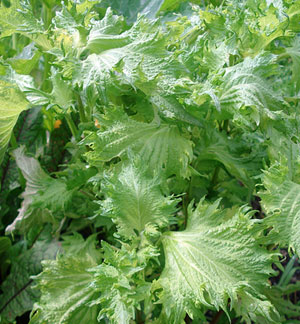
I am finally getting around to sowing some seeds for the vegetable garden. I really should have sown some things earlier, but I figure it's not too late yet.
If you are planning a vegetable garden, or even a few pots on your windowsill, and want to introduce some Japanese flavors, here's a list of some herbs and vegetables to consider growing, in order of importance and ease of growing in a temperate climate. (That's one with real winters...at least, before global warming.) The ones marked with an *asterisk can be grown in pots. A couple of my favorite seed sources are listed at the bottom.
*1. Shiso or perilla
If you can only grow one Japanese vegetable or herb, it should be shiso, or perilla (perilla fructescens). I've also seen it labeled "beefsteak plant", for what reason I know not. Shiso is used at all stages of growth. The seedlings are clipped and used as mejiso, as a fragrant garnish. The fully grown leaves, called oh-ba (big leaves), are used whole or shredded, as wrappings or garnish, as well as in pickles. And the flower buds, called hojiso, are salted and pickled. Onigiri wrapped in salted green shisos leaves are to die for.
The green shiso is the most useful one - the red shiso is usually just used for making umeboshi (pickled plums), and for hojiso. If you have the space growing both is great, but you'll need more green than red.
Since shiso leaves bruise rather easily, they are pretty expensive even if you can buy them. So, they are really worth growing yourself.
If you are lucky, shiso will self-seed itself. They did for me, but someone else mistook them for stinging nettles and pulled them all up! So, I'm sewing some anew this year.
You might find this in the ornamental seeds section,since the leaves are very attractive.
In terms of growing habits and conditions, it's quite similar to basil, so if you can grow basil you can probably grow shiso successfully. To keep the plants going keep plucking off any new buds until the weather turns cool, then let them form buds which you can cut off and preserve in salt. The only problem with shiso is that the leaves can get chewed up or get little holes drilled into them by various insects. Otherwise they are quite problem free. They do require lots of sun.
*2. Mitsuba
This is another herb that adds a really Japanese flavor to dishes. It's primarily used as a garnish, so you just need a little.
There are two kinds of mitsuba sold, but they are the same plant: regular mitsuba, and the kind with long, blanched stems. The latter kind is a pain to grow for the home gardener, but regular mitsuba grown for the leaves is very easy. Succession sowing is required. Mitsuba does pretty well in pots on a windowsill.
*3. Daikon radish sprouts
Called kaiware (which means "split shell), this is something you grow indoors rather than outside. Sew some seeds on a piece of thin washing-up sponge pushed into the bottom of a pot or a waterproof container of some kind, and keep the sponge moist. The seeds should sprout in about 2-3 days. Let them grow straight up if possible, though you can still use them if the stems curl. Used as a garnish and a salad ingredient.
4. Small Japanese turnips
Japanese turnips (kabu) are snow white and tiny compared to Western style turnips. They are very sweet and great in everything from pickles to soup to stews. The green tops can also be cooked. Provided you can prevent the pests from chewing the roots, they are very easy to grow, maturing in 30 days or so.
5. Japanese greens
[Note: this part has been edited to correct some botanical fallacies and confusion!]
There are many easy to grow Japanese greens: Komatsuna, Mizuna, Shungiku, Nanohana, etc. Most are better when grown in cool weather. If you can manage to overwinter komatsuna (botanical name brassica rapa var. peruviridis) and other greens in the spring you'll get more tender and sweeter leaves. On nanohana (botanical name: brassica rapa var.amplexicaulis), which is rather similar to broccoli rabe or broccoli rapa , you will get some beautiful yellow-green flowers, considered as one of the harbingers of spring.
Beetles and other pests do love to make little holes in the leaves of tender greens, so you need to protect against that - if you don't mind how it looks, covering them in horticultural fleece is the best way. Note that in Japan, greens (including spinach) are usually allowed to grow to full size rather than picked as 'baby leaves' for salads.
*6. Japanese eggplants / aubergines
Japanese eggplants or aubergines are small, black and slim. You can substitute eggplants sold as "Chinese", which are a bright purple and very slim, but you can't really substitute large Western style eggplants.
Growing eggplants is rather advanced gardening, especially in cool climates. I have had the best success growing them in large pots in a protected location. They require a rich growing medium, frequent fertilizing and lots and lots of water. If you're up to it though, they will reward you with tons of gorgeous little eggplants that keep giving and giving.
*7. _Shishito_ chili peppers
Shishito chili peppers are mildly spicy, rather like jalapeño peppers. They're usually eaten while still green. Very nice as tempura and in many other dishes. If you can grow other kinds of peppers, chili or sweet, then you can grow shishito.
*8. Green onions
You use such a lot of green onions in Japanese cooking that it can be quite worthwhile to grow some in the garden. You need to sow then in succession for a continuous supply. They are quite easy to grow. There are lots of varieties, but I just grow a general "evergreen" type. You can grow these in pots or growing boxes. You can even try planting up the cut off bottoms of store-bought green onions - they will sprout!
9. Kabocha, or Japanese squash
You need lots and lots of space to grow squash. Japanese squash, or kabocha, are sweet, dense and decidedly not watery. I've had mixed success with kabocha, but when I have gotten some to ripen successfully we've spent the rest of the year talking about how good they were.
10. Daikon radish
I find daikon difficult to grow because we have rather stony soil, so the daikon roots often end up splitting in odd ways. Also, you can buy daikon or mouli quite easily in stores, so it may not be worth the effort. But your own are always better, of course, especially since you can also eat the delicious green tops, which most stores in Europe and the U.S. seem to cut off.
11. Gobo or Burdock root
Gobo, or burdock root, is very hard to get a hold of unless you have access to a fairly good sized Japanese grocery. But it's also very hard to grow. It requires very deep digging to avoid it splitting into multiple thin roots, and it takes a long time to mature. But that earthy, crunchy flavor is an integral part of many Japanese dishes.
12. Japanese cucumbers
Japanese cucumbers are small, very thin and quite seedless. Worth growing if you like to eat lots of raw cucumber in salads and so on. Grow like other cucumbers, ideally on a trellis.
Other vegetables
I've had mixed, mostly bad, experiences trying to grow these:
- Edamame. The tips tend to get attacked by tiny black beetles, even while bush beans are growing near them happily. I guess they must be very tasty. I may try them again though, because nothing beats really fresh edamame.
- Soramame, or broad beans. Also very popular in England. I need to sow these in the fall I think...sowing them in the spring yields rather sickly and poor bearing plants. (Note, I'm not much of a gardener!)
I'd also like to get my hands on some myo-ga root. And if I could grow a real ume tree...
Some favorite seed sources [UPDATED]
My favorite Asian seed mail order source by far is Evergreen Seeds in Anaheim, California. I have been buying seeds from them forever, and my mother used to buy seeds from them back in the early '80s for her garden in Long Island, New York. They ship internationally, which is so rare for a U.S. based company. They carry lots of Asian (as in Chinese/Korean/Thai) seeds besides the Japanese ones.
KCB Samen is a great online store based in Basel that sells a huge variety of squash seeds, including several kabosha varieties. A more detailed review.
Kitazawa Seed Company in Oakland, California is another good mailorder source (though their website seems to be broken at the moment). I don't think they ship outside of the U.S. though.
I'd also like to mention Real Seeds, especially for UK and European gardeners. While they don't really carry a lot of Japanese vegetable seeds, I just love their whole attitude. They don't sell any F1 hybrids, just heirloom and open pollinated varieties. They actively encourage you to save your own seeds - unheard of for a seed supplier! Their web site is so fun to read I bought way more seeds from them than I needed.
A reader recommends Nicky's Nursery in the UK. They have some 'Oriental' vegetable seeds, green, red and bi-color shiso seeds, and so on. They ship to Europe and 'Rest of World', but not to the USA or South Africa due to import restrictions by those countries.
A lot of general seed catalogs, like Thompson and Morgan, Burpee's, Mr. Fothergills etc. do sell some Japanese vegetable seeds. Thompson and Morgan is my favorite big seed catalog, mainly because they ship worldwide. (The two major Swiss seed companies, Select and Samen Mauser, are good sources for vegetable seeds in general, but they don't carry any Japanese vegetable seeds. They have great selections of green beans though.)
See also
Filed under: japanese vegetables shopping gardening herbsAbout Japanese ingredients and substitutions
[Updated to add Substitution section.]
See also: Sake and mirin redux etc.
I haven't exactly counted it up, but of the thousands of comments left on Just Hungry, not to mention Just Bento, probably at least a quarter are questions about ingredients or ingredient substitutions. So I thought I might put down what my criteria are for what kind of ingredients I choose to feature in the recipes on either site, especially when it comes to Japanese recipes. [Update added on August 15th, 2008]: I've also added some suggested, and acceptable, substitutions.
Can I get a hold of it?
In case you didn't know, at the moment I live in a country with a fairly miniscule Japanese expat or immigrant population (the last I heard there were less than 2000 Japanese people living in the Zürich area). There is only one real Japanese grocery store near me, and it is quite small with a limited selection of products. There's also an equally small (though slightly better stocked) Korean grocery store, and a couple of Chinese grocery stores. (See Where I shope for Japanese/Asian ingredients in Zürich.) I supplement what I can get locally by placing an order with Japan Centre a few times a year.
My point is, that what I can get is fairly limited compared to many people, though more generous than others. So by sticking to what I can get here, I think that I'm in a good middle ground for people trying to cook anything Japanese. If you live in a region (e.g. most of California, New York City, or Hawaii) with big Japanese expat/immigrant populations, you have a much bigger selection available to you than I do!
(My mom also sends me things from Japan periodically, but I do not include the more exotic things in the recipes here, though I might mention then in passing.)
Is it available by mailorder?
I also periodically check to see if certain ingredients are available online. Some online merchants don't have very comprehensive listings on their web sites, but by emailing them they can tell you if they have something in stock.
Where to look for Japanese ingredients
In order of the likelihood of finding Japanese ingredients:
- Japanese grocery stores, including online stores. This is obvious. Please consult the Worldwide Japanese grocery store list for your area, and go to your nearest store to see what they have! That's the best way to get acquainted with unfamiliar ingredients.
- Korean grocery stores. A lot of Japanese ingredients are used in Korean cooking.
- Chinese grocery stores and general Asian grocery stores. Chinese grocery stores tend to stock less Japanese ingredients than Korean grocery stores, but you can still find a lot of things.
- Health food stores, including online stores. Many dry and/or vegan ingredients, such as rice flour, kuzu powder, agar-agar, miso and so on can be found at health food stores.
- South East Asian grocery stores (Thai, etc.) These stores don't stock Japanese ingredients per se, but some of the fresh product and things can be used.
- South Asian grocery stores (Indian, Sri Lankan, etc.) These can be a surprisingly good source for 'exotic' vegetables and such that are used in Japanese cooking.
Is it a widely used ingredient in Japanese cooking?
In general, I try to stay away from any ingredient that might be considered to be too regional or esoteric in Japan, and stick to ingredients that are likely to be in any Japanese kitchen.
Is the recipe something that is normally made in Japan?
When I do traditional Japanese recipes here, I try to stick to ones that are commonly made in Japanese homes (vs. something exotic, regional or so complicated it's only available in restaurants).
The exception to this rule is when I try to make something that is readily available in Japan, but not necessarily elsewhere. An example of this is really fresh tofu. The hard work required is worth it for the results.
Ingredient substitutions
In certain cases, you can make substitutions without a problem. I try to include substitution recommendations whenever possible, or when I am fairly sure it would work. For instance, many Japanese recipes call for katokuriko (片栗粉)which is a flour made from potato starch, but this is hard to get outside of Japan in most places. Cornstarch (or cornflour) has a very similar texture and performs the same function, so that is an easy substitute. Using honey or syrup instead of maple syrup will change the flavor a bit but also works.
In some cases though there is no substitution. If you are making kuzumochi, you really can't use anything other than kuzu powder if you want the same texture.
Sometimes you just need to try out a substitution to see if it works. For instance, when I call for a specific rice flour like shiratama-ko or joushinko, but you can't get it, try substituting a rice flour you can get and see how it goes. (I 've made rice dumplings with red rice flour from Sri Lanka, and it turned out fairly well.) The worst that can happen is that you end up with an inedible dish that you have to throw away, but that's not the end of the world. Don't be afraid of making mistakes!
Some acceptable substitutions
[This section added on August 15, 2008]
- Mirin and sake. I think more people ask about substitutes for these two ingredients than anything else put together. Both are alcoholic beverages (though mirin is never drunk and is only used in cooking). Mirin is stronger and sweeter than sake. Sake can be used as a substitute for mirin (with an added pinch of sugar), and vice versa. If you cannot get a hold of either, you can use sweet sherry or Chinese shiaoxing wine. If you cannot use alcohol for religious or other reasons, even though most of the alcohol will evaporate after cooking, just leave it out - it will affect the flavor, but there's no reasonable non-alcoholic substitute that I can think of. See also: The role of alcohol, onion and garlic in Japanese meat dishes (also applies to fish dishes in many cases) (Vinegar is not a good substitute. Vinegar makes things sour. I can't believe there are people saying that vinegar is a substitute for sake. Is vinegar a good substitute for wine in a recipe? Please.) Mirin style seasoning or mirin choumiryou (example here) has less than 1% alcohol content, so it can be used as a mirin substitute in terms of flavor. However, mirin style seasoning often has additives like MSG and sugar, so I'm not a fan of it. If you do leave out mirin from a recipe, you can add a bit of (or more) sugar to the recipe to compensate for the sweetness at least.
- Japanese-style or sushi rice. Keep in mind that 'sushi rice' is a name given by non-Japanese sellers to Japanese style or japonica medium grain rice. Medium-grain Italian rices that are used for risotto, such as vialone and arborio, are acceptable substitutes for Japanese rice; long grain rices including basmati and jasmine rice are not.
- Dashi stock. Japanese stock is usually made from kombu seaweed, dried bonito flakes (katsuobushi), dried fish called niboshi, or a combination of all or two of these. (See basic dashi recipe.) You may find it difficult to find these ingredients, or they may be too expensive. Powdered or granular dashi stock is similar to stock cubes, and can be used instead of made-from-scratch dashi; keep in mind that dashi granules are saltier and often contain MSG. See also vegan dashi stock made with dried shiitake mushrooms and kombu seaweed. If you can't get a hold of any of these, you can use a basic vegetable stock instead - it won't taste that Japanese but it's better than plain water at least!
- Miso and soy sauce. There are no substitutes for these. As to whether you should stick to Japanese soy sauce or use other kinds - I do believe that Japanese soy sauce tastes quite different from, say, Chinese soy sauce, but your palate may not be able to detect a big difference. Kikkoman is the most famous Japanese brand, and is available worldwide.
- Japanese tonkatsu sauce or okonomiyaki sauce, or "bulldog" sauce. Bulldog is the brand name of a popular line of barbeque-type sauces that are used in a lot of dishes, from panfried noodles (yakisoba) to deep fried pork cutlets (tonkatsu) , okonomiyaki, takoyaki and more. If you're in the U.S., you can use A-1 Steak Sauce, maybe tempered with a little added sugar and/or ketchup. Elsewhere, you can use Worcestershire sauce for the flavor if not the texture.
- Rice vinegar. White balsamic vinegar is the best substitute, but that's rather more exotic I think than rice vinegar! You can use also use a mild white wine vinegar instead, with a pinch of sugar to mellow it out.
In the vast majority of recipes here on Just Hungry as well as on Just Bento, I try to stick to these flavoring ingredients, plus universal ones like salt, pepper and sugar, so hopefully you won't run into too many problems around here at least.
Are there any other ingredients you'd like to know possible substitions for? Let me know in the comments.
See also
- Essential Japanese ingredients
- Essential equipment for Japanese cooking
- A dozen Japanese herbs and vegetables to grow
Kouya Dofu or Kohya Dofu, Freeze Dried Tofu
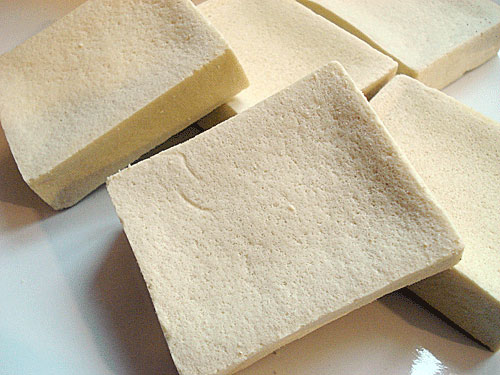
I've talked a little about kohya dofu or kouya dofu (高野豆腐)in the past, but I thought I'd describe it in detail so that I can refer back to it when I use this very versatile Japanese pantry staple in recipes.
Kouya dofu is freeze dried tofu. It's a long lasting pantry staple of most Japanese households. It comes in plastic packaging, usually 5 to a pack, like so:
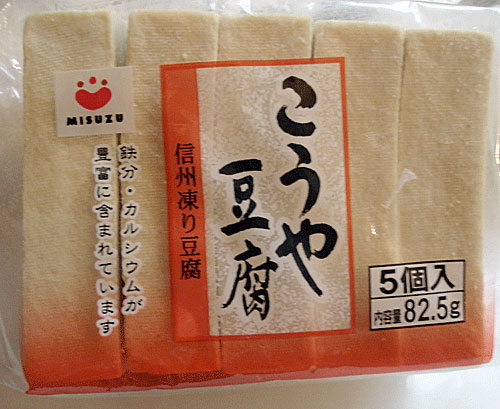
Each square is about the size of a business card, and about 1cm or 1/2 inch or so thick. Each kouya dofu square is about 90 calories. They look like dehydrated squares of bread, or one of those sponges that you soak in water to reconstitute and use. The packets require no refrigeration.
Indeed, it is a sponge - a block of tofu that's been reduced to its cell structure. It's a very old traditional preserved food, that probably got invented by accident when someone left out some tofu in the winter and it froze solid. It's made by repeatedly freezing and thawing tofu, until all the moisture can be extracted.
Usually, kouya dofu is used by reconstituting it first. The easiest way is to soak it for a while in boiling water to cover. When the water has cooled down enough for the tofu to be taken out and genty squeezed, it's ready to use. It swells up to about 3-4 times its original size.
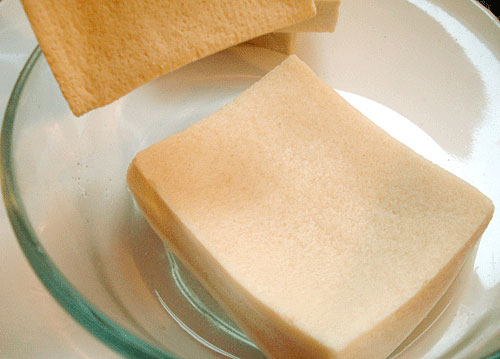
From here, you can just cut it up and use it in soups or stews. You can also marinate it. It has a more dense and firm texture than regular tofu, and like regular tofu it soaks up any flavor it is soaked or cooked in. It's usually stewed in a standard japanse soy sauce - mirin - sake - dashi - sugar mixture.
Here I've cooked some reconstituted kouya dofu in the same way that I cooked frozen tofu cutlets, to make kouya dofu nuggets. But I didn't have to take the time to freeze and defrost regular tofu. The results are much 'meatier' than nuggets made with frozen regular tofu. You might even be able to fool some unsuspecting people into think it's some sort of meat....
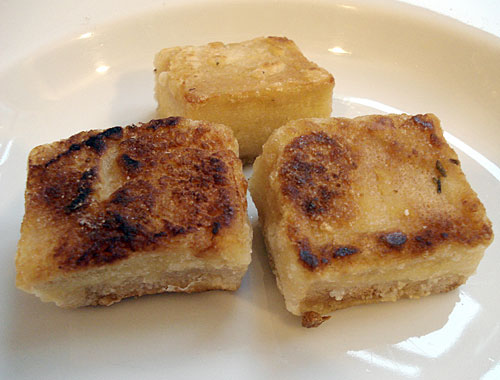
Another interesting way of using kouya dofu is to turn it into a powder by grating it or whizzing it in a food processor. The powder can be used instead of breadcrumbs, as a filler or binder in burgers and meatballs. This can be a good thing for celiacs and gluten intolerant people. The spongy texture soaks up any excess moisture and flavors. And of course, it provides and extra protain boost.
In Japan, kouya dofu is very cheap. Outside of Japan it can be more expensive, but the packet of 5 in the photo above was only $1.99 at Nara Foods in Port Washington, Long Island. So, look for it next time you are in a Japanese grocery store and give it a try, especially if you or someone you cook for has gluten allergies, or are vegan or vegetarian.
Filed under: japanese ingredients vegetarian tofu veganLooking at rice
(I've updated this very popular post with some info about germ rice (haiga-mai) and sprouted brown rice (hatsuga genmai). In case you missed it the first time around, here it is again in your RSS reader and on the front page.)
Rice is a big part of my food life. While I do like other kinds of carbohydrates, especially good bread and pasta, rice is definitely my favorite.
There are so many different kinds of rice though. Even if one leaves out the rather more exotic kinds like red rice from the Camargue, American wild rice (which is not actually a rice but a kind of grain) or black rice (kokumai), I usually have on hand several different kinds of rice, each with a different use. Here are the ones I have in the pantry right now that I use in everyday cooking.
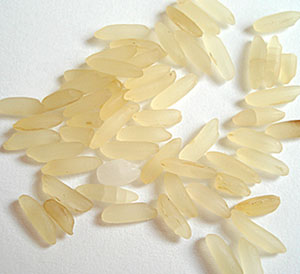 This is the long grain, parboiled rice, the kind that is most commonly used in European and American cooking. The grains don't stick together, for that separate, 'fluffy' texture that American/UK cookbooks find desirable. To me this is the most boring kind of rice with little character of its own. Nevertheless it is the least expensive kind of rice usually, and has its uses. I use this for rice dishes that have a lot of added flavor, like pilafs or fried rice. It can not be used as a substitute for japonica rice in most traditional Japanese dishes, since it is it not sticky enough.
This is the long grain, parboiled rice, the kind that is most commonly used in European and American cooking. The grains don't stick together, for that separate, 'fluffy' texture that American/UK cookbooks find desirable. To me this is the most boring kind of rice with little character of its own. Nevertheless it is the least expensive kind of rice usually, and has its uses. I use this for rice dishes that have a lot of added flavor, like pilafs or fried rice. It can not be used as a substitute for japonica rice in most traditional Japanese dishes, since it is it not sticky enough.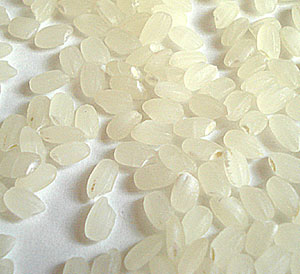 This is Japanese-style rice, or uruchi-mai - the kind of rice I talk about the most on this site. It is also sold as medium grain rice, or sushi rice. It's the rice to use for almost any kind of Japanese dish, including the all-important sushi and onigiri. The rice grains cling together without being mushy when properly cooked. This rice must be polish-washed to bring out its best flavor, as I have previously described. The best kinds of this rice have a translucent quality and have clean, rounded grains. As you can see, the grains are rounder compared to long-grain rice.
This is Japanese-style rice, or uruchi-mai - the kind of rice I talk about the most on this site. It is also sold as medium grain rice, or sushi rice. It's the rice to use for almost any kind of Japanese dish, including the all-important sushi and onigiri. The rice grains cling together without being mushy when properly cooked. This rice must be polish-washed to bring out its best flavor, as I have previously described. The best kinds of this rice have a translucent quality and have clean, rounded grains. As you can see, the grains are rounder compared to long-grain rice.A variation of white uruchimai is haigamai (germ rice, 胚芽米). It's hulled and polished white rice with the germ left intact. This is a bit more nutritious than regular white rice. This is getting more available at Asian/Japanese groceries.See this excellent tutorial on Instructables for how to sprout brown rice.
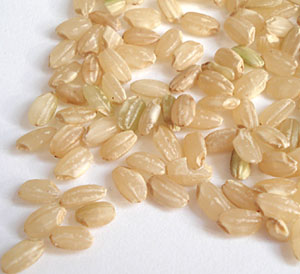 This is gen-mai, the brown version of uruchi-mai. It requires more water and a longer cooking time than the polished version. If you are in the market for a new rice cooker you may want to look for one that can cook brown rice. I've been eating more of this instead of the polished rice recently. Since the bran that is on brown rice contains oils that can turn rancid, it should be as fresh as possible. (Update: how to cook brown rice in a pot on the stovetop.)
This is gen-mai, the brown version of uruchi-mai. It requires more water and a longer cooking time than the polished version. If you are in the market for a new rice cooker you may want to look for one that can cook brown rice. I've been eating more of this instead of the polished rice recently. Since the bran that is on brown rice contains oils that can turn rancid, it should be as fresh as possible. (Update: how to cook brown rice in a pot on the stovetop.)One way to process brown rice, which is supposed to make it much more nutritious, is to let it germinate or sprout. This turns it into hatsuga genmai (literally, "sprouted brown rice", 発芽玄米, also known as GBR in health-food/vegan circles). To sprout rice on your own, soak it in lukewarm water for 24 hours, and keep it in a warm place (I keep mine on top of the hot water tank). At the end of the 24 hours, you may see the end of the grains are splitting a bit, and evena tiny little white root peeking out - that means it's sprouted. If it hasn't sprouted yet, rinse the grains and cover again with lukewarm water. If it still hasn't sprouted by the end of another 24 hours, it probably never will, so you can just cook it before the grains start fermenting actively. Since the grains have been soaked for so long you can cook it as you would white rice (in a rice cooker for example). It is softer and supposed to be easier to digest than regular brown rice.
You can also purchase sprouted rice - look in health food stores.
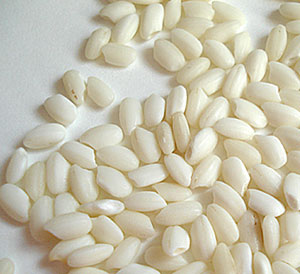 This is mochi-mai, or mochi rice, otherwise called sweet rice, short-grain rice, or sticky rice. The grains are not really that much shorter than the "medium-grain" uruchi-mai above but as you can see, the grains look quite different. The are opaque and white rather than transculent. This is beaten and kneaded to make glutinous mochi cakes, used to make osekihan (red rice with beans), or used for some sweets.
This is mochi-mai, or mochi rice, otherwise called sweet rice, short-grain rice, or sticky rice. The grains are not really that much shorter than the "medium-grain" uruchi-mai above but as you can see, the grains look quite different. The are opaque and white rather than transculent. This is beaten and kneaded to make glutinous mochi cakes, used to make osekihan (red rice with beans), or used for some sweets. 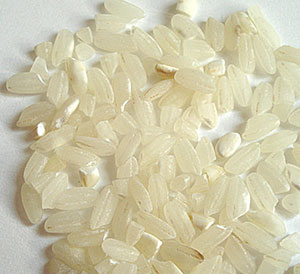 This is vialone rice from Italy. I use this or arborio rice for making risotto. It actually looks quite similar to uruchi-mai or japonica rice. These medium grain Italian rices can, a pinch, be used instead of Japanese rice. This is useful to know if you live in an area where vialone, arborio and other Italian rice varieties are cheaper than Japanese rice (which is certainly the case in Switzerland...we are a lot closer to Italy than to Japan after all). The reverse holds true too - if you have more or easier access to Japanese rice than arborio, vialone or carnaroli, you can use that, unrinsed, for risotto. When used for Italian dishes rice is not rinsed, since the powder that clings to the grains is the substance that makes risotto creamy.
This is vialone rice from Italy. I use this or arborio rice for making risotto. It actually looks quite similar to uruchi-mai or japonica rice. These medium grain Italian rices can, a pinch, be used instead of Japanese rice. This is useful to know if you live in an area where vialone, arborio and other Italian rice varieties are cheaper than Japanese rice (which is certainly the case in Switzerland...we are a lot closer to Italy than to Japan after all). The reverse holds true too - if you have more or easier access to Japanese rice than arborio, vialone or carnaroli, you can use that, unrinsed, for risotto. When used for Italian dishes rice is not rinsed, since the powder that clings to the grains is the substance that makes risotto creamy. 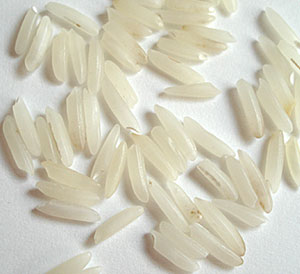 The final kind of rice that is a staple in our house is basmati rice. It has the longest grain of all, and a translucent appearance. It also has a a distinctive sort of spicy aroma, which matches spicy dishes perfectly. I keep this on hand of for Indian and Thai type dishes. I often have Thai 'perfume' or 'jasmine' rice on hand too, which is quite similar in cooking qualities. Neither basmati or jasmine rice can be used successfully in traditional Japanese dishes such as onigiri or sushi, since they are not sticky enough.
The final kind of rice that is a staple in our house is basmati rice. It has the longest grain of all, and a translucent appearance. It also has a a distinctive sort of spicy aroma, which matches spicy dishes perfectly. I keep this on hand of for Indian and Thai type dishes. I often have Thai 'perfume' or 'jasmine' rice on hand too, which is quite similar in cooking qualities. Neither basmati or jasmine rice can be used successfully in traditional Japanese dishes such as onigiri or sushi, since they are not sticky enough.See also
Filed under: japanese ingredients riceLooking at tofu
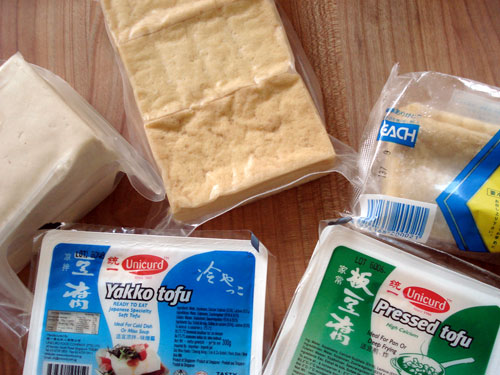
(Periodically I like to dust off an article from the vast Just Hungry archives, give it a little facelift, and present it on the front page again. I wrote this guide to tofu back in September 2008. I think it will answer most, if not all, your questions about Japanese-style tofu and related products. Enjoy!
There are several tofu recipes both here in Just Hungry as well as on Just Bento, and I've even shown you how to make your own tofu from scratch. However, up until now I have never really tried to explain the differences between types of tofu, when to use them and how to store them. Well now is the time to fix that.
Fried tofu type 1: Aburaage
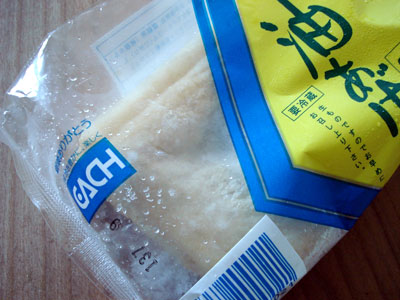
Aburaage (油揚げ)is deep fried tofu, where almost none of the soft white tofu remains. It's also called tofu skin or tofu pocket sometimes. When the tofu is deep fried, an air pocket is formed inside which can be stuffed, as in inarizushi or eggs in treasure bags. Besides stuffing it, you can use aburaage sliced up and put into soups or stir-fries, gently cooked whole in a broth as in kitsune udon, and more.
To get rid of the excess oil on the surface, blanch aburaage in boiling water for a couple of minutes, then drain away. To loosen it up so that it's easier to stuff, roll a round chopstick over the surface several times after blanching to loosen it up, then cut open.
The best way to store aburaage for longer than a few days is to freeze it. (The bag in the photo is actualy frozen.)
Japanese aburaage is always a rectangular sheet, but you can get small puffs or squares in Chinese markets.
Note: Don't confuse aburaage with canned (or packaged) inarizushi (or 'bean bag' sushi) skins, which have been cooked in a sweet-salty sauce. That is just one way to prepare aburaage. The canned inarizushi skins do tend to be rather high in salt, sugar and MSG, though they are very convenient to use. See how to make inarizushi from scratch, using plain aburaage.
Fried tofu type 2: Atsuage or namaage
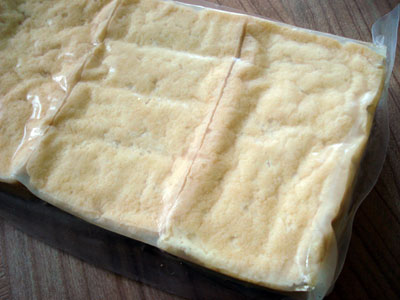
Atsuage (厚揚げ)or namaage (生揚げ)is a block of tofu that has been slowly fried in oil until it forms a slightly crinkly pale brown skin. It's stil white tofu inside though, unlike aburaage. You can get rid of the excess oil on the surface just like with aburaage, by blanching it in boiling water. Aburaage is a very versatile food, that can be pan-fried or grilled like a steak, cut up and used in stir-fries or stewed, put into soups and so on. I like using aburaage in bento recipes a lot - because it has less moisture than non-fried tofu, it keeps longer.
The two main types of plain tofu
Finally we get to plain tofu. Plain tofu can be divided into two main types: silken or kinugoshi (絹ごし), and firm or pressed. In Japanese firm tofu is called momen (木綿)or cotton tofu. Here are a block of each: silken on the left, and firm/cotton on the right.
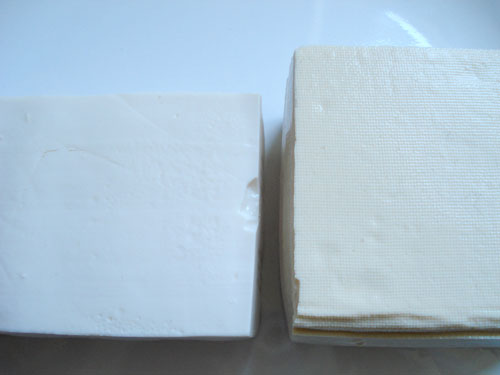
Here are the blocks from the side:
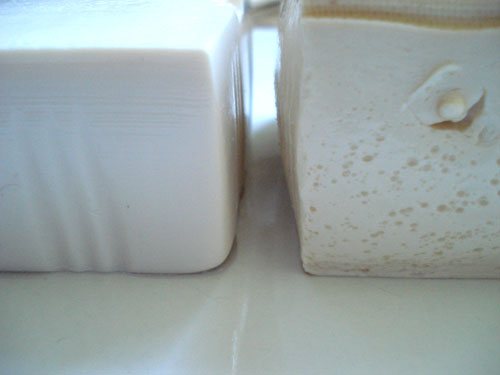
As you can see, the silken tofu is smoother and more watery, while the firm/cotton tofu is well, firmer and denser. Since silken tofu is much softer (higher water content), it is harder to handle if you want the tofu pieces to not fall apart. So if you are a tofu beginner and you want to use it on stir-fries or things like bacon wrapped tofu, you will want to use firm tofu. Firm tofu is less liable to fall apart, especially if you drain off the water a bit. Some recipes call for extracting even more water from the tofu (see using tofu for bento friendly recipes). On the other hand, silken tofu is more suited for recipes that call for it to be pureed, such as quick tofu pudding and baked squash and apple pudding, or in smoothies. I prefer silken tofu in miso soup, though firm is fine too.
Some other tofu types not pictured here
I don't have these on hand so pictures are missing...
Yaki dofu (焼き豆腐)is firm tofu that's been grilled on the outside, giving it a nice flavor.
Kouya dofu (高野豆腐)is freeze-dried tofu that is sold in the dried food section. It looks like little dried beige sponges. This is reconstituted in water before stewing. It can be a good pantry staple because it keeps indefinitely. Update: All about kouya dofu
Yuba (湯葉) is a Kyoto speciality. Thin films of tofu are scooped off the top of vats of warm soy milk. It's available in dried form and is usually used in soups and such. Fresh yuba made from fresh warm soy milk is considered a great delicacy and is usually eaten with a litle soy sauce, yuzu juice and such.
How to keep tofu fresh
Once you open the vacuum sealed pack the tofu comes in, any leftovers must be stored in an airtight container in the refrigerator, immersed in water. You will need to change the water every day too, but in any case don't keep opened tofu for more than 2 or 3 days. (With homemade tofu the shelf life is even shorter - a maximum of 2 days.) If you leave tofu out of water for more than a day in the fridge, it will take on a sour taste, not to mention picking up stray refrigerator smells! It is possible to freeze tofu (see frozen tofu cutlets) but the texture will change.
As mentioned above, aburaage can be frozen. Firm atsuage can also be frozen, though the inner texture will change a bit.
Calories in tofu products
Per 100 grams or about 3.5 oz:
- Aburaage: 386 calories (one piece is about 20-25g) This is the calorie count before getting rid of the surface oil, so after it's cooked it would be a bit lower in calories.
- Atsuage: 150 calories - (one piece is anywhere from 100 to 200g, depending on the brand etc.) This is the calorie count before getting rid of surface oil.
- Silken tofu: 56 calories
- Firm/cotton tofu: 72 calories
- Yaki dofu: same as firm tofu
- Kouya dofu (dry weight): 590 calories
- Kouya dofu (cooked weight): 130 calories
- Yuba (cooked weight): 150 calories
What about those stories I hear about soy being good for you/bad for you?
Whenever I write about soy or tofu products here, I usually get some comments or emails about how soy products are either bad for you (the current trend - makes men grow breasts and so on) or good for you (prevents certain types of cancer and what have you).
My attitude about these types of reports is this: Tofu has been eaten for hundreds or thousands of years. Generally speaking soy products are a great source of vegetable based protein and fat. And in any case, no one should be eating massive quantities of any one food product every day of the week, as seems to be the case with those reports of body builders taking lots of soy protein powder and sprouting boobies and such. Even the most die hard tofu fan in Japan, like my mother, does not eat tofu every single day. (For what it's worth, she has IBD and finds tofu to be one of the few easily digestible proteins.) Variety is the spice of life, and your diet! See also: A problematic report on the dangers of soy.
Hopefully most if not all of your tofu related questions have been answered here. If not, ask away in the comments!
See also
- How to make your own ganmodoki - a kind of tofu fritter that's available in packaged form, but is much better when freshly made
- Tofu from bean to plate - a small family-run company in Kyoto that makes tofu and also runs a wonderful tofu-kaiseiki restaurant. Includes pictures of special types of tofu and soy milk - tofu at its best!
Miso Basics: A Japanese miso primer, looking at different types of miso
[From the archives. This miso primer was published here last September (2008). I've added some notes about miso-based blends, especially sumiso or miso with vinegar.]
This is a post that has been a long time coming. I kept on holding it off until I had a good variety of miso on hand to show photos of. I can't say I have a comprehensive selection to show you, but I hope you will find this article useful anyway.
Miso (味噌、みそ), as you probably know already, is a naturally fermented paste made by combining cooked soy beans, salt, and often some other ingredient such as white or brown rice, barley, and so on. The texture can range from smooth to chunky, and the color from a light yellow-brown to reddish brown to dark chocolate brown, and the flavor ranges from mildly salty and sweet to strong and very salty. It is packed with umami and protein, not to mention all sorts of nutrients.
Miso-like fermented bean products and pastes exist all over Asia, but here I will mainly limit myself to the most commonly used Japanese misos.
Some general rules of miso
The color can be a fairly good indicator of the strength of flavor, age and saltiness of the miso. Generally speaking, the lighter in color of the miso, the sweeter (less salty) it is. Light colored misos are also younger than dark colored ones in general.There are exceptions to this rule, but if you are confronted with a selection and don't know which way to go, it's useful to remember.
The longer a miso is aged, the deeper in flavor it gets, though it can get a bit odd if aged too long. Commercially available miso is usually aged from 6 months to 2 years. (Note: Many misos made by health-oriented companies (e.g. Eden Foods in the U.S., Clearspring in the UK) do not seem to be aged too long, and therefore lack depth of flavor. If you're just eating miso for health reasons you may not care, but otherwise you are forewarned.)
You can keep unopened miso at room temperature indefinitely. Once opened, store well covered in the refrigerator - though it won't go 'off' that fast really. Ideally you want to consume it within a year of purchase. (I've kept miso for 3 years in the fridge without any ill effects, but I don't really recommend you do that!)
Major types of miso by color
Shiromiso (白みそ)or 'white' miso is the generic term for golden-yellow to medium brown miso. It is milder than other kinds of miso, with a slight sweetness. It's the most versatile one for cooking purposes - you can use it for miso soups, miso marinades, and so on. If you can only afford one kind of miso budget-wise or space-wise, get a good shiromiso that is labelled 'medium sweet'.
Akamiso (赤みそ)or 'red' miso is the generic term for miso that is a dark reddish-brown in color. It is usually (but not always!) more salty and assertive in taste than shiromiso. If you see a red-brown miso that is labelled a inakamiso (田舎味噌)or 'country' miso, you can be pretty sure that it will be strong in flavor and fairly salty.
Awasemiso (合わせ味噌)or 'blended' miso is just that, miso that combines two or more different types of miso together. This is also a good general choice if you don't want to assemble a miso collection.
With or without dashi?
Since miso is so often used in conjunction with dashi stock, some misos already have dashi added to them. These are usually labeled dashi iri (だし入り). If you want to add your own homemade dashi, or you are a vegan and want to avoid any fish products in your miso (see vegan dashi), look for additive-free or mutenka (無添加)miso. If you can't tell from the label whether it has dashi or not, look at the ingredient list - an additive free miso should only have soy beans, salt, rice or barley if they are used, and perhaps some fermentation ingredients (usually listed as koji (麹)).
Organic/not-GM?
If you want to be sure to get miso that is made from soy beans that are organically grown and not genetically modified, look for ones that say yuuki (有機). Most if not all miso that say mutenka (無添加)or additive-free are also non-GM . You may also encounter miso that says it's made from kokusan (国産)or domestic (Japanese) soy beans; this usually (thought not always - so check!) means it's made from non-GM, happy soy beans. (See above note about misos made by Western health-oriented companies.)
Gluten free?
Unless the miso contains barley (麦、mugi) or wheat (小麦、komugu) it is gluten-free, unless it has some not-traditional additives.
Some misos to look for by name
You may see a number of 'brand' names for miso, such as Shinshuu, Yamato, etc. Most of these names don't really mean much except to indicate where the miso comes from - the differences are too subtle except for a diehard miso connoisseur. There are a couple that stand out though.
- Hatcho miso (八丁味噌)is a type of miso made in the Tokai region (now the 3 prefectures of Aichi, Mie and Gifu). It was traditionally said to have been served to the emperor and is held in high regard. It's an all-soybean miso, which is about medium on the sweet/strength/saltiness scale, and is a good general purpose miso.
- Saikyo miso (西京味噌) is a golden yellow miso that was traditionally made in the Kyoto/Kansai region. It is naturally sweet - the sweetness comes from the sugar produced as a byproduct of the fermentation process, similar to amazake (甘酒). Makes a good dipping sauce or condiment, and is used as a sweet flavor in baked goods and so on by some Japanese vegan cooks. Does not keep as well as other miso types since it's lower in salt, so you must refrigerate it. It's very expensive! (I noticed that the Nobu restaurant group has a recipe online for 'saikyo' miso, but it uses white sugar! That's just sweet miso sauce, not Saikyo miso.)
- Moromi miso (もろみ味噌)is a mildly salty, chunky miso, usually with added grains of rice or barley that is meant to be eaten as a condiment rather than in cooking. It's used rather like a dip on raw vegetables and things like that. (One of my teachers used to insist that moromi miso on raw cucumbers would make us smarter.)
Miso based sauces or blends
These are not pure misos, but are sauces or blends with miso.
- Sumiso (酢みそ)is miso with added vinegar, sugar and mirin. It's used as a condiment, marinade, and so on.
- Miso blend for marinade, or misozuke (味噌漬け)is miso with added mirin, soy sauce, konbu seaweed, and so on. Commercial blends often have MSG or "flavor enhancers" in them.
How to get a good miso?
As with many things in life, generally speaking the more expensive a miso is, the better it's going to taste. Do be sure you are comparing like-to-like when looking at prices though. Generally, special misos like Saikyo miso, or ones with special additives like brown rice miso, tend to be more expensive than general white, red or blended miso. Also, organic/additive-free misos tend to be a bit more expensive.
The only way to really know if a miso is good or not is to taste it. So, if you are trying out a new to you miso, try to get the smallest package possible and try it out.
You may think me prejudiced, and I probably am, but I do think that miso made in Japan generally tastes better than miso made elsewhere. Not to name names, but I've tried some non-Japanese brands, and they are lacking in depth of flavor, even if they are sometimes more expensive!
Making miso at home
I have not tried this myself yet, so I have nothing to show you, but you can make miso at home. All you need is soy beans, salt, some ko-ji (麹)(a sort of fermented rice starter), a big bucket, space, and patience - since you need to age the miso for 6 months to a year. You can find instructions on the interweb. (Maybe one day I will try making my own...)
What I have in my kitchen now
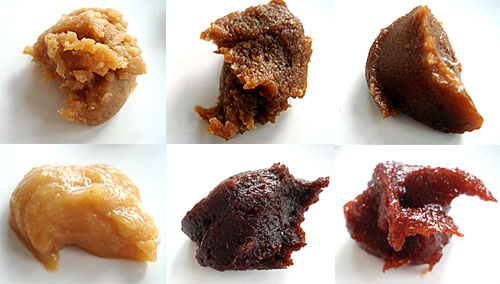
The top row shows the three misos I use the most: two types of shiromiso, and an awasemiso. One shiromiso is a big chunkier in texture and has brown rice in it; the other shiromiso and the awasemiso are both all-soy bean types. I use any of the three for most if not all the recipes here on Just Hungry or over on Just Bento. There's no good reason for me to have two shiromisos and an awasemiso - I just like trying out stuff.
The second row shows misos I use a lot less. On the left is a Saikyo miso, and in the middle is some quite salty-strong akamiso. I use Saikyo miso in some baking experiments and as a sauce to go with stewed daikon radish and such. The red miso is used for some marinades and some miso soups.
Lastly, since I had a square to fill and I only have 5 kinds of miso on hand at the moment, I've included some Korean gochujang (or kochujang as it's pronounced in Japan), although it's not a miso at all. It is however a fermented soy bean paste with added wheat, spices and so on.As you can see much redder than the 'red' akamiso - since I use it almost as much as miso because I love it so much.
The basics of Japanese cooking and all that
What actually prompted me to finally post this was an article I saw elsewhere that was titled What Is Miso Paste? It stated that miso and rice for Japanese people are like 'meat and potatoes for Americans'. Heh?
Sure, miso is part of Japanese cuisine. But you do not always eat miso, or always have miso soup, with a meal, if that was the analogy they were trying to use. Sure, soup is often served with a meal in Japan, but it can just as well be a clear soup as a miso soup. The real basis of Japanese cooking is rice, dashi and _sa shi su se so_. If you whittle it down to the bare essentials, a bowl of plain, white rice and something salty to go with it makes me feel Japanese through and through.
But enough of my whinging. If you have any questions about miso that I haven't answered here, ask away!
See also
- Japanese Basics: Miso and Miso Soup
- A week of miso soup, day 1, day 2, day 3, day 4, day 5, and wrapup
- Make your own instant miso soup balls
- Miso marinade for meat or fish
- All entries filed under miso on Just Hungry and Just Bento (also try the search function on the site since I may haved missed correctly tagging some miso posts!)
Basics: Japanese soy sauce - all you need to know (and then some)
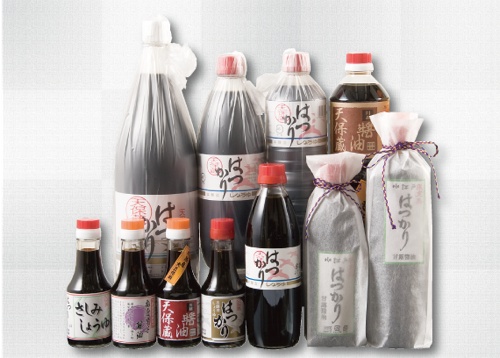
(An exhaustive look at Japanese soy sauce. Originally published in December 2011, revised and edited in August 2012.)
I've written so many articles here on Just Hungry over the almost nine years of its existence, that I've forgotten half of them. But one thing I have not really done so far is delve into the subject of one of the most important ingredients in Japanese cooking, shoyu (醤油)or soy sauce. I have written about soy sauce briefly in years past, but I feel now is the time to go deeper.
Note: I am talking here only about Japanese soy sauce. Soy sauce is made by other Asian cultures of course, where processes and ingredients may differ. I'm sticking to what I'm familiar with here as usual.
So, let's dive in to the world of Japanese soy sauce.
How is soy sauce made?
Like miso, soy sauce is a fermented and aged product. The kanji characters for soy sauce or shoyu are 醤油, which literally means 'fermented food oil' - so in Japanese and Chinese there's no 'soy' at all in the 'soy sauce' name. In the olden days, many foods were salted and fermented for longer shelf life and flavor. For instance the ancient Romans liked a thing called garum, a strongly flavored condiment or sauce made from fermented fish. The fish sauces that are essential for south east Asian cooking are salted-and-fermented-food products too. (Did you know there are several Japanese fermented fish sauces too? The most well known one is called shottsuru (しょっつる)and is made in Akita prefecture, in the Tohoku region.)
Generally soy sauce is made from a mixture of soy beans, wheat, salt and yeast. Some types of soy sauce also include fermented rice (kome koji) or amazake to give sweetness to the flavor. Mass produced soy sauce is made from defatted soy residue (soy from which the oil has been extracted), which makes the soy sauce ferment a lot faster than using the whole bean. Purists argue that this also leads to a loss of flavor and body. The wheat and/or rice is necessary to feed the yeast as the mixture ferments, and to develop a sweet flavor in the soy sauce.
Here's how they make soy sauce at a traditional soy sauce maker (shoyu-ya) in Chiba prefecture:
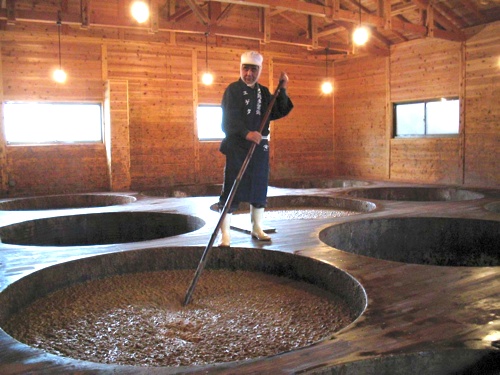
Here's a nice big vat fermenting away...
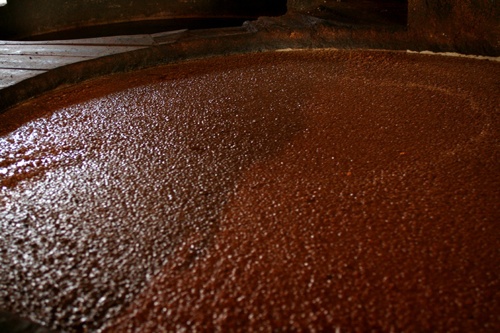
Of course this is not how it's done at say, Kikkoman factories around the world. But the process is fundamentally the same.
Soy sauce is typically aged at least 6 months before it is bottled, though some are aged longer. While 'standard' soy sauce (see koikuchi below) usually does not have any additives, in some cases things are added (usually alcohol) to prolong the shelf life of soy sauce, or sweeteners to give it a sweeter flavor. By Japanese law, all such additives must be clearly indicated on the label. So if you're looking for a soy sauce that's as natural as possible, look for one with no additives.
Types of soy sauce
There are 5 main traditional types of shoyu or soy sauce. The type of soy sauce used in largely influenced by what part of the country you live in, or where the cook of the family grew up. (I know a lot of people outside of Japan tend to think it's all the same and homogenous, but at least when it comes to food that's certainly not the case.) Typical Japanese households stock just 1 or 2 types of soy sauce, unless they are really into cooking.
The most widely used type by far is koikuchi (濃い口)soy sauce. Koikuchi literally means 'dark mouth'. This is the quintessential soy sauce that you see for sale from brands like Kikkoman and Yamasa in Japanese grocery stores around the world, and since it is the 'starndard' soy sauce for many people it is not always labeled as koikuchi. Koikuchi soy sauce sales account for more than 80% of the market in Japan according to the Soy Sauce Information Center (SOYIC - Japanese only website). It's the soy sauce of choice in the Tokyo/Kanto area and the north. Koikuchi soy sauce is usually made with equal parts of soy and wheat, plus salt and yeast.
This is the soy sauce I use in all of my recipes here on Just Hungry as well as on JustBento unless specified otherwise. Why? Well for one thing I'm from Tokyo, and my mom and her mom and my father's mom were all from the Kanto region. So we are koikuchi folks. Also, koikuchi soy sauce is the 'standard' as noted above, and much easier to get a hold of than other types.
The second most popular type of soy sauce is usukuchi (淡口; kanji scholars may notice that the kanji 淡い is used rather than 薄い). This is a lighter colored, used primarily in western Japan, namely the Kansai region (Kyoto/Osaka), and has about 15% of the soy sauce market share. In traditional Kyo-ryori (Kyoto cuisine), which has its origins in refined imperial court cooking, dark colored koikuchi soy sauce is considered declassé and ruins the flavor and appearance of food. However, don't think that because it's lighter in color that it's less salty. On the contrary, usukuchi soy sauce is saltier than koikuchi soy sauce - 18-19% of its volume is salt, compared to around 16% for koikuchi. In recipes that call for usukuchi soy sauce this is taken into account. Usukuchi soy sauce is also made with soy and wheat, and is often rounded out with the addition of fermented rice (kome koji), wheat gluten or amazake.
Another type of soy sauce that became popularized in the west is tamari (溜まり)- which means 'pooled residue'. It is a thick, almost viscous soy sauce, which originated in the Chuubu region (central Japan; the main city in the area is Nagoya). It's used mainly as a dipping sauce for sashimi, and to finish off certain dishes to give a burnished reddish- brown color and shine, e.g. to teriyaki dishes. Tamari became popularized in the west because it got the reputation that it was made without wheat. This is not necessarily the case - especially if it's a tamari made the traditional way. If you must stay away from any kind of wheat please check the label. (Tamari made with 100% soy does exist.)
(*A note about gluten intolerance and soy sauce. Much of the wheat gluten is broken down and basically consumed by the yeast during the long fermentation process. I've looked at the blogs of many Japanese celiacs, and they all say they don't worry about consuming small amounts of soy sauce. But of course, Your Body May Vary. Kikkoman does make a gluten-free soy sauce, but I'm not sure if it's for the overseas market only.)
Finally we come to two very regional soy sauces. Saishikomi (再仕込み)soy sauce originates south-western Japan, especially Yamaguchi prefecture. It's unique in that it is re-brewed (that's what 'saishikomi' means) from a previous batch ofmade soy sauce. This means the color is very intensely dark red-brown, and the flavor is less salty and sweeter more rounded than other soy sauces. And then there is shiro (白) or white shoyu that originates in Aichi prefecture. It's even lighter in color than usukuchi shoyu - it's about the color of dashi stock made with lots of katsuobushi (bonito flakes), and has become rather trendy to use amongst some chefs in Japan who want to add some soy sauce flavor to dishes but not color. (Outside of Japan, certain trend-conscious chefs have started specifying usukuchi soy sauce. They need to catch up. ^_^)
Reduced salt soy sauce
Reduced or low-sodium salt soy sauce, called genen (減塩)or teien (低塩) is koikuchi soy sauce that has had its salt content reduced mechanically so to speak.The salt content of reduced sodium soy sauce ranges from 9 to 13%. (Don't confuse reduced salt soy sauce with usukuchi (light) soy sauce, as noted above.)
Grades of soy sauce
Soy sauce is graded both by the Japaneese Ministry of Agriculture, Fishing and Forestry (JAS) and an industry group called the Japanese Soy Sauce Association. The official government grades are Special Grade (特級, tokkyuu), First Grade (1級, ikkyuu) and Standard Grade (標準, hyoujun). Grading is based on measuring the chemical composition soy sauce, mainly for its amino acid and alcohol content. The Japanese Soy Sauce Association adds two more grades that are higher than Special Grade: Extra Select (特選, tokusen) and Ultra-Extra Select (超特選, choutokusen).
Soy sauce is also graded by experts based on color, aroma, roundedness and other such more subjective criteria.
As with most Japanese things, you tend to get what you pay for when it comes to soy sauce.
Other things to look for on a label might be "yuuki" which means grown without chemical fertilizers or pesticides (almost organic), and "marudaizu" which means the soy sauce is made from the whole soy bean rather than defatted dregs.
Generally speaking, people tend to use expensive, special soy sauces and very assertively flavored ones straight up, for dipping and other uses where it is not diluted by other ingredients.
What is nama-shoyu or ki-joyu?
Nama-shoyu (生醤油) - unpasteurized soy sauce - seems to be the new trendy thing these days in the U.S. It's exactly what it says - soy sauce that has not been heated to kill off any good or bad organisms. Natural-food fans like it because it's, well, unpasteurized. Does nama-shoyu always taste better? I'm really not sure. I personally think that the soy sauce made by skilled, experienced artisans is the best, regardless of whether it is 'raw' or not.
Is nama-shoyu a health food? In my opinion, anything with the high levels of sodium soy sauce has can never really be a "health food". It's a condiment and flavoring, something to be used in small amounts. In that sense, and this is just my humble opinion of course, nama-shoyu is not worth the expense over a good old pasteurized soy sauce. Pasteurization is not 'bad' for you you know - it's one of the greatest innovations in human history. Before pasteurization, people died regularly from food poisoning and such.
Many people in Japan called nama-shoyu ki-joyu; both terms have the same kanji characters (生醬油). I've read that they are both the same, and also that ki-joyu is just a culinary term used by chefs and such to say 'straight soy sauce' without the addition of mirin, sake or other ingredients. In English speaking areas at least nama-shoyu is the term used.
So now my head is spinning. What soy sauce do you recommend?
If you can only afford one soy sauce type (budget or space-wise) in your kitchen, get the best koikuchi (or regular) soy sauce you can afford. It's really the best all-rounder. I usually buy Yamasa Marudaizu or regular Yamasa. I just prefer Yamasa over Kikkoman, but that's just a personal preference. (And by the way, I do stick to Japanese brands; I just find they taste better to me. I tried an 'organic' soy sauce made in the UK once and it was just..lacking.) I do have a couple of extra-special, artisanal soy sauces around purchased in Japan, but they are not really necessary and I actually rarely use them, except for dipping.
If you dislike the dark color soy sauce gives to dishes, or have gotten into Kyoto style cooking, you'll want to use usukuchi soy sauce, but it does tend to be more expensive than koikuchi. Your local Japanese grocery store will stock both koikuchi and usukuchi soy sauces, as well as tamari and maybe other types. Your local general-Asian grocery store will probably only have koikuchi (plus soy sauces from other nations).
Nowadays you have a wide selection of soy sauces to choose from in the U.S. as long as you're willing to mailorder - go nuts if you want! In France/Europe, be sure to look up Workshop Issé if you want to go high-end with your soy sauce.
I hope I've covered all of your soy sauce questions! If not, let me know in the comments as always.
Filed under: basics japanese ingredients washokuJapanese basics: Nanban sauce or vinegar (Nanbansu)
I've been craving sour flavors recently for some reason (and no I'm not pregnant ^_^;), which means that I've been making nanban foods quite a bit. The word _nanban_ uses the kanji characters for 'south' and 'savage', meaning savages who come from the south. It was originally used to refer to the Portuguese, the first non-Asian foreigners to land on Japanese soil. Later it came to refer all foreigners except for long-time neighbors China and Korea - or in other words, the Europeans. I guess to the Japanese of the 16th century or so, those white people looked like otherworldly savages! In any case, it seems that the Portuguese had some kind of dish that had sour flavors (I haven't been able to pin down what that dish might have been - if anyone has a clue let me know), and so the term 'nanban' came to be used for any dish had a combination of sweet/sour/salty and often spicy-hot flavors.
Nanban sauce or vinegar is most commonly used for nanban dishes. For instance Chicken nanban is a dish that originated at a popular restaurant in Miyazaki prefecture in the southern island of Kyuushuu back in the 1950s, and is basically battered deep fried chicken that's been doused in this sauce and served with a ton of of tartare sauce. It was popular in Kyuushuu for decades, but only became well known nationwide in the last decade or so when it became a popular item on _famiresu_ (family restaurant) menus, as well as in convenience store bentos. _Wakasaki no nanban zuke_ is another popular dish, consisting of small, whole ice fish (which are a bit like little sardines) that are deep fried and doused in nanban sauce with lots of shredded vegetables. Nanban sauce can also be used on noodles, or with either cooked or raw vegetables. It makes an unusual salad dressing.
I'll have specific recipes that use nanban sauce later on, but I wanted to write down the basic recipes so I can point to them instead of repeating them over and over. There are almost as many nanban sauce recipes as there are households and restaurants that make nanban dishes, but here I have three variations. Just pick the one that looks the most appealing to you. Any one of them can be kept for at least week or two in the refrigerator.
Update: Check out my panfried chicken nanban on JustBento.
Recipe no. 1: Classic nanban sauce
By Makiko Itoh
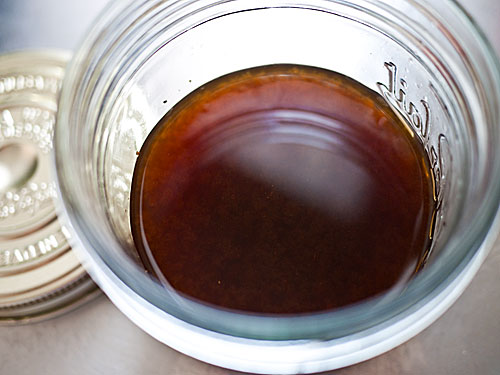
Published: March 04, 2011
A version of a versatile Japanese vinegar based sauce that can be used as a marinade, dipping sauce, dressing and more. This is a classic version using mirin.
Prep time: 5 min
Cook time: 5 min
Total time: 10 min
Yield: 2 cups
Ingredients:
- 1/2 cup (120ml) rice vinegar, (plain rice vinegar, not sugar vinegar, which has salt in it already)
- 1/2 cup (120ml) mirin, (a sweet fortified alcoholic cooking ingredient)
- /14 cup (60ml) dark soy sauce, (this is the regular dark brown soy sauce that is widely available)
- 4 tablespoons sugar
- 1 piece about 4 inches (10cm) long dried konbu seaweed, (a basic ingredient in Japanese cooking, used for its umami)
- 1 tablespoon Worcestershire sauce, (optional)
- 2-3 small red Thai red chili peppers or similar, cut into rounds, (remove seeds if you don’t want it to be too spicy)
- 1/2 teaspoon salt
Combine all the ingredients in a small pan,
Heat and stir until the sugar is melted; heating it also takes the edge off the vinega and makes it milder.
Cool and put in a screwtop jar.
Store in the refrigerator, where it will keep more or less indefinitely. If you want to keep it in your pantry instead, just strain it off and pack into clean, sterile jars.
Recipe no. 2: Alcohol-free Nanban Sauce
By Makiko Itoh
Published: March 04, 2011
An alcohol-free (no mirin) version of a versatile Japanese vinegar based sauce that can be used as a marinade, dipping sauce, dressing and more (Since classic nanban sauce is not cooked for a long time, it still has some alcohol in it, which may be a concern if you're going to use it as a dipping sauce or dressing.) The honey in this adds an interesting dimension. See Recipe no. 1 for ingredient descriptions.
Prep time: 5 min
Cook time: 5 min
Total time: 5 min
Ingredients:
- 1/2 cup (120ml) rice vinegar
- 1/4 cup (60ml) runny honey
- 1 piece about 4 inches/10 cm long dried konbu seaweed.
- 1 tablespoon Worcestershire sauce
- 2 tablespoons ketchup
- 2-3 small red Thai chili peppers, (Use another hot red chili pepper if you can't find Thai peppers. Remove the seeds if you want it milder.)
- /21 teaspoon salt
Directions:
Combine all the ingredients in a small pan,
Heat and stir until the sugar is melted; heating it also takes the edge off the vinega and makes it milder.
Cool and put in a screwtop jar.
Store in the refrigerator, where it will keep more or less indefinitely. If you want to keep it in your pantry instead, just strain it off and pack into clean, sterile jars.
Recipe no. 3: Nanban sauce with leeks
By Makiko Itoh
Published: March 04, 2011
Another version of the versatile Japanese vinegar based sauce that can be used as a marinade, dipping sauce, dressing and more. This is a bit more elaborate than the other two, but really good. It also has less sugar, since the leeks are quite sweet anyway. (See description of ingredients under Recipe no. 1 above.)
Prep time: 5 min
Cook time: 10 min
Total time: 15 min
Yield: 2 cups
Ingredients:
- 1 white part of a leek, roughly chopped
- 1 teaspoon vegetable oil
- pinch salt
- 1/2 cup (120ml) rice vinegar
- 1/2 cup (120ml) mirin
- 1/4 cup (60ml) dark soy sauce
- 1/4 cup (60ml) water
- 2 tablespoons sugar
- 1 piece about 4 inches / 10 cm long dried konbu seaweed
- 1 cup dried bonito flakes (katsuobushi)
Directions:
Heat a frying pan over medium heat, and add the oil.
Sauté the chopped leek until soft and lightly browned
Combine all the ingredients in a small pan, Heat and stir until the sugar is melted.
Cool and put in a screwtop jar.
Store in the refrigerator, where it will keep more or less indefinitely. If you want to keep it in your pantry instead, just strain it off and pack into clean, sterile jars.
Notes
If you have kids or people who don't like spicy food, omit the chili peppers. If you like extra heat, add more.
Try out this non-recipe: Heat up some leftover fried chicken until hot in the oven. Even KFC will do. Douse the hot chicken in some nanban sauce, and let cool again. This is really nice for bentos and picnics.
(Technical note: I am trying out some search-engine friendly recipe tagging, which accounts for the repeated use of extraneous information like Author: Makiko Itoh for each recipe. Please bear with me as I iron out the glitches.)
(Another note: I mistakenly deleted the original post, together with all of your comments! At least I did have a backup copy of the original article. My apologies to everyone who left a comment...;_;)
Filed under: basics japanese sauce yohshoku washoku - Karasumi